|
Copyright, Attention: This website and its contents contain intellectual property copyright materials and works belonging to the National First Ladies’ Library and Historic Site and to other third parties. Please do not plagiarize. If you use a direct quote from our website please cite your reference and provide a link back to the source.
First Lady Biography: Ellen Wilson
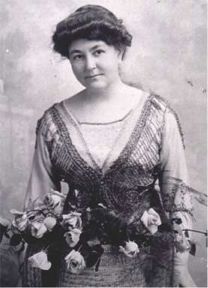 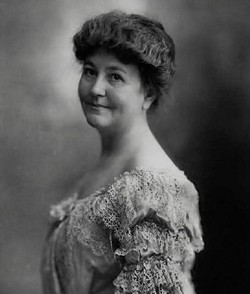
ELLEN LOUISE AXSON WILSON
Born:
15 May, 1860
Savannah, Georgia
Ellen Louise Axson was named after two aunts and born in the home of her paternal grandparents.
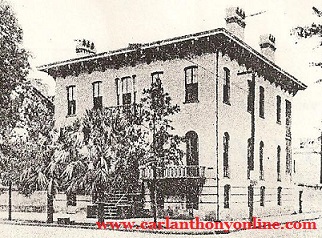 Father: Father:
Samuel Edward Axson, was born 23 December 1836, in Waltourville, Georgia. In 1856, he enrolled at Oglethorpe College, to study for the ministry, and was ordained in 1859, assigned to the pastorate of Beech Island, South Carolina, a year after his marriage and a year before the birth of his daughter Ellen. Axson was the pastor of the First Presbyterian Church in Rome, Georgia.
Edward Axson served in the Confederate Army as the First Regiment, Georgia Infantry chaplain from 1861 to 1863. He then assumed the Presbyterian Church pastorate of Madison, Georgia, relocating his family there and also serving as a teacher for the town’s children in a private school created by the community with classes being held in the Axson home.
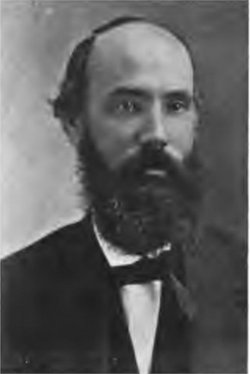 Just after the Civil War ended, Axson accepted the pastorate of the First Presbyterian Church in Rome, Georgia, which had been decimated during the war and faced the challenge of rebuilding. Just prior to the death of his wife in 1881, Axson suffered a nervous collapse, the first in a series of mental health problems that would trouble him for the rest of his life. He was hospitalized at a mental health facility the following year and died two years later on 28 May 1884. All evidence suggests that he committed suicide. Just after the Civil War ended, Axson accepted the pastorate of the First Presbyterian Church in Rome, Georgia, which had been decimated during the war and faced the challenge of rebuilding. Just prior to the death of his wife in 1881, Axson suffered a nervous collapse, the first in a series of mental health problems that would trouble him for the rest of his life. He was hospitalized at a mental health facility the following year and died two years later on 28 May 1884. All evidence suggests that he committed suicide.
Mother:
Margaret Jane Hoyt Axson was born 8 September, 1838, in Athens, Georgia. The last of six children, she was educated well at the Greensboro Female College in Greensboro, Georgia. Enrolled there from 1853 to 1856, she won numerous academic awards and developed a voracious reading habit.
Following her graduation, Janie Hoyt Axson took a job at the college, working there for two years as a teacher. She is one of the earliest known examples of a First Lady’s mother who was professionally employed prior to her marriage. Janie Hoyt (as she was known) married Edward Axson (as he was known) at the First Presbyterian Church, Athens, Georgia in 1858 in a ceremony over which both of their fathers presided.
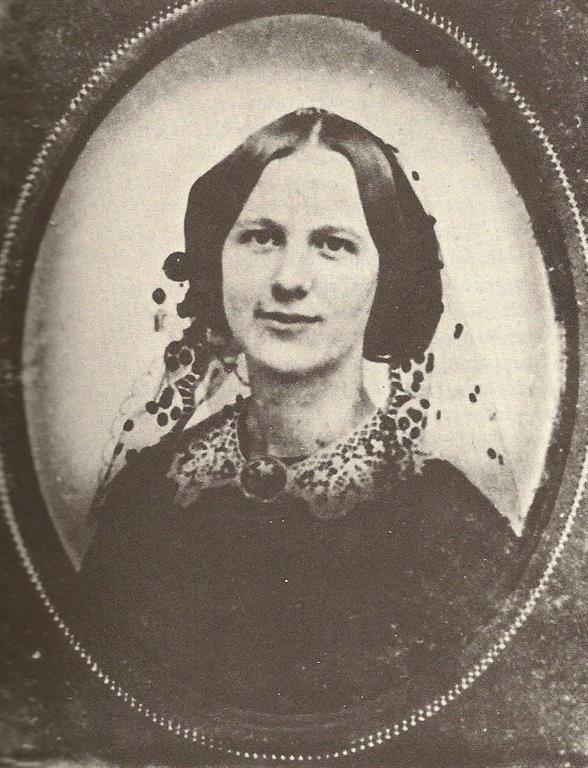 Herself a rapid consumer of all forms of literature, she inculcated her daughter Ellen with a similar passion of reading, both for pleasure and research. She died on 1 November 1881, shortly after giving birth to her fourth child Herself a rapid consumer of all forms of literature, she inculcated her daughter Ellen with a similar passion of reading, both for pleasure and research. She died on 1 November 1881, shortly after giving birth to her fourth child
Ancestry:
English. The patriarchal line of her father’s family originated in England but settled in Bermuda. In 1684, they migrated from Bermuda to South Carolina. Despite her close public identity with the South, three of Ellen Wilson’s grandparents were from the North. Her father’s mother Rebecca Randolph was from a Princeton, New Jersey family. The family of her mother’s father was from Somerset, England, her immigrant ancestor John Hoyt settling in Salem, Massachusetts nine years after the Pilgrims established Plymouth, the first in what became Massachusetts Bay Colony. Her great-great grandfather fought in the French and Indian Wars and helped capture Fort Ticonderoga from British troops in 1775, as part of the famous “Green Mountain Boys,” led by Ethan Allen. Ellen Wilson’s maternal grandfather was born in Gilmanton, New Hampshire and her maternal grandmother in Springfield, Massachusetts.
Religion:
Presbyterian. Ellen Wilson’s father and both grandfathers were Presbyterian ministers.
Siblings:
Ellen Wilson was the first-born of four children, two brothers, one sister: Isaac Stockton Keith Axson (6 June 1867 – 26 February 1935), Edward Williams Axson (1876- 26 April 1905), Margaret Randolph Axson [Elliott] (10 October 1881 – 24 May 1958)
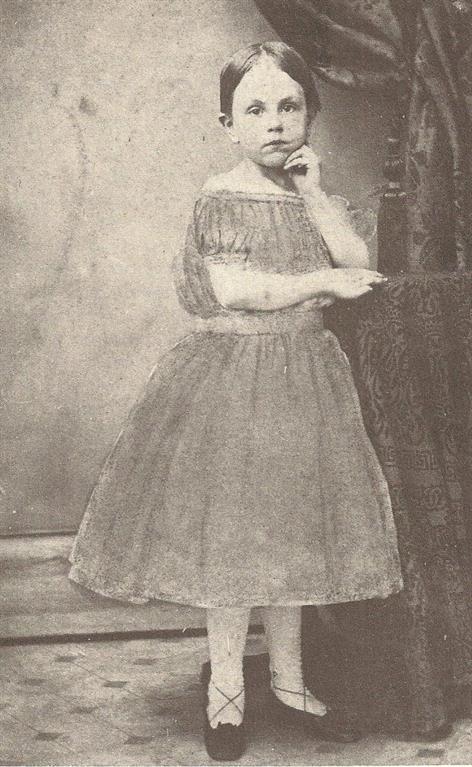 Education: Education:
The Madison Male and Female Academy, Madison, Georgia (1864-1865). Pre-school. Ellen Wilson appears to be the first First Lady to have received a formal pre-school education. Established by her parents in the immediate aftermath of the Civil War, with classes conducted in their Porter Street home, Ellen Wilson was only four years old at the time her formal education began.
The Sabbath School, Rome, Georgia (1865-1871), grammar and middle school.
Little is known of the nature of this school or its academic training, other than that students also received religious training. Since its foundation and teaching was part of the church work being managed by her father, as well as the fact that her mother was an experienced educator, and that she graduated in 1871 with “satisfactory evidence of knowledge and piety,” Ellen Wilson received a rigorous enough education enabling her to proceed on to a more formal institution at the age of eleven.
Rome Female College, Rome, Georgia, (1871-1876), high school.
Biographer Frances Wright Saunders chronicled that Ellen Wilson received an education here in algebra, logic, botany, natural history, philosophy, and geometry, excelled in English literature, composition and French and even taught herself trigonometry. The discipline which proved to have the most profound affect on her, however, was the study of art, beginning with drawing instruction from teacher Helen F. Fairchild, a graduate from the prestigious National Academy of Design in New York.
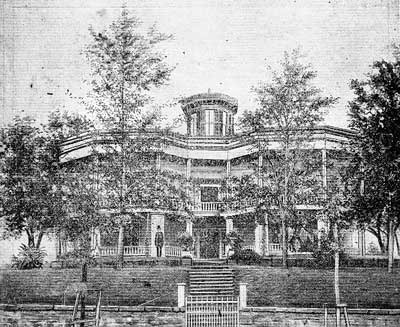 Following her graduation, Ellen Wilson continued to study art with Fairchild. In 1878, Fairchild submitted a freehand drawing of a “school scene” by Ellen Wilson at the Paris International Exposition, and the work won a bronze medal for excellence. Following her graduation, Ellen Wilson continued to study art with Fairchild. In 1878, Fairchild submitted a freehand drawing of a “school scene” by Ellen Wilson at the Paris International Exposition, and the work won a bronze medal for excellence.
Excelling in proficiency entry exams required in her application to Nashville University’s education department, Ellen Wilson intended to follow her mother’s path, to pursue training and employment as a teacher. Her father, however, was unable to afford the tuition and Ellen Wilson was unable to further her education in Tennessee as hoped.
She continued her education through self-study by pouring through books at the local library and enrolled in post-graduate classes at Rome Female College, studying German, advanced French and continuing to advance in drawing. By the time she was 18 years old, she began earning a substantial income by drawing crayon portraits.
 Art Students League, New York, New York (1884-1885), college-level. Following an independent trip to New York in 1881, Ellen Axson had determined to professionally develop her considerable skill as an artist. After being accepted at the Art Students League on the basis of two submissions, she moved to New York, enrolling in several courses and living in a boardinghouse, supporting herself with inheritance from her late father’s estate. She took classes in charcoal portrait-drawing, sketching of students, sculpture drawing, advanced painting and attended weekly lectures on perspective. Her skill earned her a prestigious placement in a specialized sketching class which used nude and draped live models. The school was considered radical for its administration by its students and their gender equality. Art Students League, New York, New York (1884-1885), college-level. Following an independent trip to New York in 1881, Ellen Axson had determined to professionally develop her considerable skill as an artist. After being accepted at the Art Students League on the basis of two submissions, she moved to New York, enrolling in several courses and living in a boardinghouse, supporting herself with inheritance from her late father’s estate. She took classes in charcoal portrait-drawing, sketching of students, sculpture drawing, advanced painting and attended weekly lectures on perspective. Her skill earned her a prestigious placement in a specialized sketching class which used nude and draped live models. The school was considered radical for its administration by its students and their gender equality.
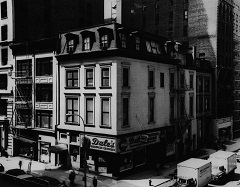 Appearance: Appearance:
Five feet, three inches tall; light brown hair, dark brown eyes
Life before marriage:
Due the danger of living near active war zones during the Civil War, the infant and toddler Ellen Wilson would live in Athens, Savannah and Madison, Georgia all before the age of five. Her first permanent home was a two-family house on West First Street in Rome, Georgia where her family settled for a year in 1865, followed by at least one if not two other homes there. The family finally purchased their first home in 1871, on East Third Street, where Ellen Wilson’s maternal grandmother came to live with them.
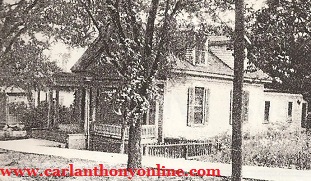 From the earliest records of her life, Ellen Wilson displayed ability for scholarship, even dictating to her mother her first letter to her father before the age of three. She was so voracious a reader that her mother grew concerned for her health at times. Her favorite author was George Eliot and she especially was drawn to English literature and American poetry. From the earliest records of her life, Ellen Wilson displayed ability for scholarship, even dictating to her mother her first letter to her father before the age of three. She was so voracious a reader that her mother grew concerned for her health at times. Her favorite author was George Eliot and she especially was drawn to English literature and American poetry.
As she matured into a young adult, Ellen Wilson began expressing views at odds with the views of her parents and religious training about the need for all women to assume the traditional role of wife and mother. While she loved and respected her parents, she also felt free to express her independent opinion on a range of social issues.
Apparently more for her physical attributes than her unusually keen intellect, Ellen Axson had long appealed to a wide variety of young men. At least five young men avidly courted her, one persisting for four years in proposing marriage, another seeking to bring her on a religious missionary assignment to China. She so rigidly refused to even consider marriage as she matured, let alone dating, that her friends nicknamed her “Ellie, the Man Hater.” Among the specific qualities she wrote that she required in a potential marital partner was that he be “intelligent and interesting.” Ellen Wilson also developed a loving but platonic relationship with another young woman, Elizabeth Adams, with whom she shared an intensely emotional correspondence.
Following the nervous breakdown her widowed father endured in 1883, the Axson household broke up, the youngest daughter raised by a maternal aunt, the eldest son in boarding school and Ellen Wilson and her younger brother living in Savannah, Georgia in the home of her paternal grandparents where she had been born.
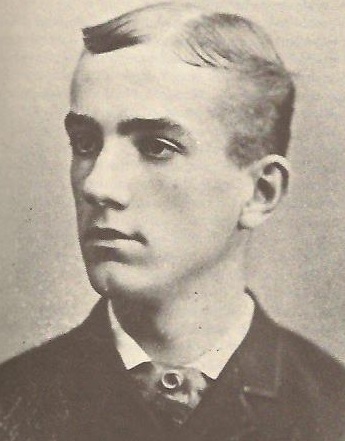 Ellen Wilson assumed responsibility for closing up her family’s household in Rome, as well as overseeing the hospitalization and continued treatment of her father who, after displaying violent behavior, was committed to the Georgia State Mental Hospital in Milledgeville. She also assumed responsibility for aiding her elderly and infirm grandparents. These self-imposed tasks further deepened her sense that being a caretaker to those in need was her natural lot in life. Ellen Wilson assumed responsibility for closing up her family’s household in Rome, as well as overseeing the hospitalization and continued treatment of her father who, after displaying violent behavior, was committed to the Georgia State Mental Hospital in Milledgeville. She also assumed responsibility for aiding her elderly and infirm grandparents. These self-imposed tasks further deepened her sense that being a caretaker to those in need was her natural lot in life.
In April of 1883, shortly after the death of her mother, Ellen Axson was attending a church service presided over by her father, wearing a mourning veil. Another congregant, a new attorney visiting from Atlanta, Georgia, couldn’t help staring at her, detecting that she had “lots of life and fun in her.” It was her future husband, Woodrow Wilson.
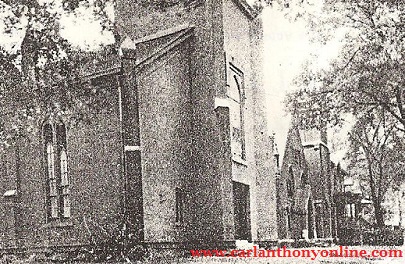 Like Ellen Axon, Woodrow Wilson also had a father who was a Presbyterian minister, the Reverend Dr. Joseph Ruggles Wilson. The two fathers were, in fact, long-time friends. The attorney used the family acquaintance as an excuse to pay a call at the Axson house. Within a month of their meeting, he penned the first of a lifetime of love letters to her. They shared a mutual acculturation, coming of age in southern states which were part of the Confederacy during the Civil War and Reconstruction. Although born in Virginia, Wilson would also spend his youth in Columbia, South Carolina and Wilmington, North Carolina. Although he attended and graduated from Princeton University in New Jersey, he returned to the South to attend the University of Virginia Law School in Charlottesville, Virginia and first began to practice law in Atlanta, Georgia. Like Ellen Axon, Woodrow Wilson also had a father who was a Presbyterian minister, the Reverend Dr. Joseph Ruggles Wilson. The two fathers were, in fact, long-time friends. The attorney used the family acquaintance as an excuse to pay a call at the Axson house. Within a month of their meeting, he penned the first of a lifetime of love letters to her. They shared a mutual acculturation, coming of age in southern states which were part of the Confederacy during the Civil War and Reconstruction. Although born in Virginia, Wilson would also spend his youth in Columbia, South Carolina and Wilmington, North Carolina. Although he attended and graduated from Princeton University in New Jersey, he returned to the South to attend the University of Virginia Law School in Charlottesville, Virginia and first began to practice law in Atlanta, Georgia.
At the time he began pursuing Ellen Axson, Wilson abandoned his law practice to attend graduate school at Johns Hopkins University in Baltimore, Maryland in preparation for a career in education as a college professor. Within two months of meeting Ellen Axson, Wilson determined to marry her, despite her seeming indifference to him. By what proved to be a propitious but entirely coincidental crossing of paths in September of 1883 at the summer resort town of Morganton, North Carolina, he was able to wear down her resistance and she agreed to marry him. She soon described him to her brother as “the greatest man in the world and the best.” Since he had begun his graduate studies in Baltimore, he sent an engagement ring to her in the mail.
Upon learning that her father had been committed to a hospital for patients with mental health problems, Woodrow Wilson made his way to Ellen Axson’s side in a show of emotional support for his fiancée. With the loss of her father’s income, Ellen Axson assumed financial responsibility for her siblings and began searching for a full-time teaching position. Woodrow Wilson assured Ellen that her two brothers would always be welcome to live in their home as members of their own nuclear family, following their marriage. Ellen Axson offered Wilson the chance to break their engagement, due to the societal shame of what was almost certainly her father’s suicide. He refused.
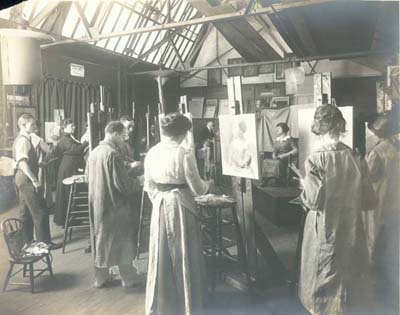 During her residency in New York City, while studying at the Art Students League, Ellen Axson avidly indulged her free time by regularly visiting the rotating exhibits throughout the city’s network of art galleries. She also became a frequent theater devotee, taking in Shakespearean productions, including three performances by Edwin Booth. She broke polite societal custom by attending lectures around the city at night, without a male escort. Deciding not to wear her engagement ring on a finger which indicated she had promised to marry Wilson, Ellen Axson also indulged in a flirtatious relationship with another man, until he learned of her commitment to marry. During her residency in New York City, while studying at the Art Students League, Ellen Axson avidly indulged her free time by regularly visiting the rotating exhibits throughout the city’s network of art galleries. She also became a frequent theater devotee, taking in Shakespearean productions, including three performances by Edwin Booth. She broke polite societal custom by attending lectures around the city at night, without a male escort. Deciding not to wear her engagement ring on a finger which indicated she had promised to marry Wilson, Ellen Axson also indulged in a flirtatious relationship with another man, until he learned of her commitment to marry.
In defiance of her strict Presbyterian training, she also opened herself up to learning the differences of other faiths, attending Sunday services to hear sermons at not just an Episcopal church but those given at the non-Christian Ethical Culture Society which offered lessons in societal morality without the basis of traditional religious texts. She walked across the new Brooklyn Bridge to hear the famous but controversial preacher Henry Ward Beecher.
Ellen Axson also began work as a volunteer Sunday school teacher of underprivileged children at the Spring Street Mission School, which worked out of a room above a popular bar with am African-American student body. She expressed the belief that while the work was necessary it would likely prove futile without an effort being made to further encourage their educations at home during the weekdays. Her fiancé also raised mild criticism of this activity, suggesting that it might not be time worthwhile spent and that the location was unsavory for her.
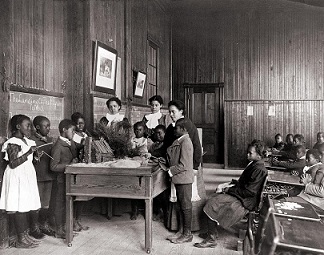 Some evidence suggests that while Ellen Wilson was never a racist in the contemporary understanding of that word, she did believe that the white and black races could never be equal. Her reasoning for this is unclear. She may have been influenced by her father’s view that the destruction of the Confederacy ruined a natural balance which placed the black race in servitude to the white and that the ensuing “sudden and absolute emancipation policy ruined one race and doomed another.” She believed it was her responsibility and that of all white people to ensure that black people were given access to healthy, secure housing and without threat of violence. Some evidence suggests that while Ellen Wilson was never a racist in the contemporary understanding of that word, she did believe that the white and black races could never be equal. Her reasoning for this is unclear. She may have been influenced by her father’s view that the destruction of the Confederacy ruined a natural balance which placed the black race in servitude to the white and that the ensuing “sudden and absolute emancipation policy ruined one race and doomed another.” She believed it was her responsibility and that of all white people to ensure that black people were given access to healthy, secure housing and without threat of violence.
During her stay in New York, Ellen Axson also evidenced her first interest in national politics by subscribing to The Nation magazine, although it “quite exercised” her thinking. It was a topic which also dovetailed with the direction of her future husband’s career. While earning his doctorate at Johns Hopkins University, his first book Congressional Government was published, prompting a frank discussion between them of their individual ambitions for independent careers. When Wilson expressed his interest in pursuing a political career, Ellen announced her intention to focus her energies into his career, a decision she reached entirely without his prompting. Wilson expressed guilt at her sacrificing a promising professional career in art, but Ellen assured him that she retained the option to resume it later in their life together.
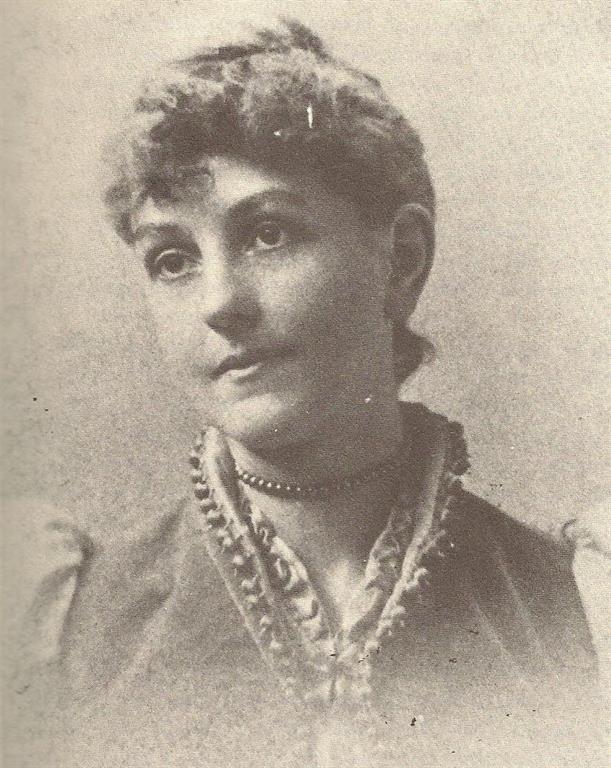
Married:
25 years old, on 23 June 1885, Savannah, Georgia, to Thomas Woodrow Wilson (born, 28/29 December 1856, Staunton, Virginia, died 3 February, 1924, Washington, D.C.). Ellen Axson and Woodrow Wilson were married in a ceremony presided over by her paternal grandfather and his father.
Children:
Margaret Woodrow Wilson (16 April 1886 – 12 February 1944), Jessie Woodrow Wilson [Sayre] (27 August 1887 – 15 January 1933), Eleanor “Nell” Wilson [McAdoo] (16 October 1889 – 5 April 1967).
Life after Marriage:
Woodrow Wilson began a teaching stint at Bryn Mawr College in Haverford, Pennsylvania at the time of his marriage. Undertaking work on his second book, one exploring comparative politics, he came to entirely depend on Ellen as a professional partner. In conducting research for his project, she used her considerable skill in German to translate for him complex political, economic and philosophical studies, pamphlets, magazine articles, and books. This level of research also required her to synthesize highly theoretical materials, deepening her intellectual grasp of government and politics. She did this at the same time that she also undertook a home economics class under the tutelage of a Mrs. S.T. Rorer in Philadelphia.
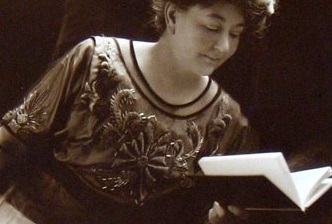 In loyalty to the South of her youth, Ellen Wilson ensured that her first two children were born in her native Georgia. As her own parents had done for her, Ellen Wilson became the first educator to her daughters, teaching them how to read, instructing them in religious training and ensuring a lack of selfishness by presenting all three with one gift each on all of their birthdays. She read them Greek mythology, Shakespeare and hired a nurse who would also teach them German and French. The fact that none of her three children were boys proved to be a tremendous disappointment to Ellen Wilson, a feeling her husband and father-in-law did not discourage. Nonetheless, the semi-permanent household presence of Ellen’s younger brother Eddie gave her husband a sense of having a son. In loyalty to the South of her youth, Ellen Wilson ensured that her first two children were born in her native Georgia. As her own parents had done for her, Ellen Wilson became the first educator to her daughters, teaching them how to read, instructing them in religious training and ensuring a lack of selfishness by presenting all three with one gift each on all of their birthdays. She read them Greek mythology, Shakespeare and hired a nurse who would also teach them German and French. The fact that none of her three children were boys proved to be a tremendous disappointment to Ellen Wilson, a feeling her husband and father-in-law did not discourage. Nonetheless, the semi-permanent household presence of Ellen’s younger brother Eddie gave her husband a sense of having a son.
When Wilson assumed a new position at Wesleyan University in Middletown, Connecticut, Ellen Wilson became further exposed to differing northern views on public issues. After befriending a Brown University professor, for example, he sent her a book with a more progressive vision of how racial equality could begin to be achieved in the U.S. Following his accepting the offer of Princeton University to chair the political economics department, the family relocated to the college town in New Jersey. In regard to societal norms affecting women, Ellen Wilson affected a more practical and compassionate perspective, assuring her husband’s middle-aged sister for example, that her late-in-life pregnancy was of no shame to the family and that she was welcome to be entertained as an overnight guest in their home.
Part of what Ellen Wilson viewed as her “mission in life” was to embolden her husband’s confidence in his abilities and vision. “It would be hard to say in what part of my life & character you have not been a supreme and beneficial influence,” he wrote her with appreciation for her subtle yet vital role in his professional success. “You are all-powerful in my development.” Still, balancing this role was her continuing streak of independent thinking and behavior. Ellen Wilson attended the 1893 Columbian World’s Fair, held in Chicago, intent on first touring the Women’s Building there. This structure was designed by a woman architect and displayed works of fine art in all forms created by women and it stirred pride and hope within her for the professional recognition and success of artists of her own gender.
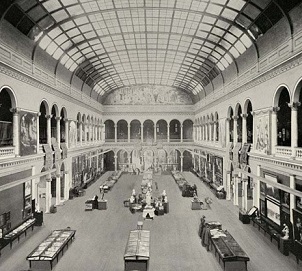
Ellen Wilson provided the preliminary architectural renderings of the two-story Tudor-style house in Princeton, which the family then had built and completed in 1896. Along with her study of architecture, her reading subjects ranged from classic and contemporary American, English and French fiction, religion, philosophy, politics, history, and all forms of art. More humorously, when male members of her family once partook of a round of cigars passed to them during a holiday celebration, Ellen Wilson also took one and smoked it, suggesting she had a right to do so if she chose. When a spate of home robberies afflicted the Wilson house neighborhood, Ellen Wilson purchased a gun, learned how to use it and kept it at her bedside during the frequent absences of her husband, in order to be prepared to defend herself, her children and their home.
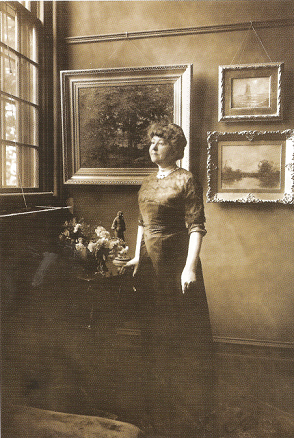 When her husband vacationed to Scotland and England in the summer of 1896, Ellen Wilson remained home and resumed painting and drawing for the first time in a decade. Using an English landscape and oil of a Madonna in the Princeton University art collection as models, she turned out expert copies, as well as watercolor landscapes and six crayon drawing portraits. She also felt free to travel and explore on her own, once visiting New Orleans to experience its famous Mardi Gras celebration at the pinnacle of its revelry. In New York, she took in a performance of avant-garde actress Alla Nazimova. In 1903, Ellen Wilson made her first trip to Europe, touring England, Scotland, France and Italy with her husband. The following year she returned without him, spending longer periods of time in individual towns and cities of Italy, where she explored works of history and art. When her husband vacationed to Scotland and England in the summer of 1896, Ellen Wilson remained home and resumed painting and drawing for the first time in a decade. Using an English landscape and oil of a Madonna in the Princeton University art collection as models, she turned out expert copies, as well as watercolor landscapes and six crayon drawing portraits. She also felt free to travel and explore on her own, once visiting New Orleans to experience its famous Mardi Gras celebration at the pinnacle of its revelry. In New York, she took in a performance of avant-garde actress Alla Nazimova. In 1903, Ellen Wilson made her first trip to Europe, touring England, Scotland, France and Italy with her husband. The following year she returned without him, spending longer periods of time in individual towns and cities of Italy, where she explored works of history and art.
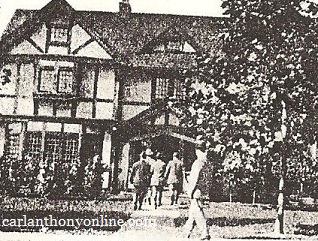 Ellen Wilson also became involved in the Princeton community. With the retirement there in 1897 of former President Grover Cleveland and former First Lady Frances Cleveland, the Wilsons found they shared not only the same Presbyterian faith and Democratic politics but three young daughters: Ruth Cleveland and Nell Wilson even became good friends. In 1898, Ellen Wilson also helped to form a local women’s organization called the “Present Day Club,” with the purpose of drawing the interest of members into not only artistic Ellen Wilson also became involved in the Princeton community. With the retirement there in 1897 of former President Grover Cleveland and former First Lady Frances Cleveland, the Wilsons found they shared not only the same Presbyterian faith and Democratic politics but three young daughters: Ruth Cleveland and Nell Wilson even became good friends. In 1898, Ellen Wilson also helped to form a local women’s organization called the “Present Day Club,” with the purpose of drawing the interest of members into not only artistic
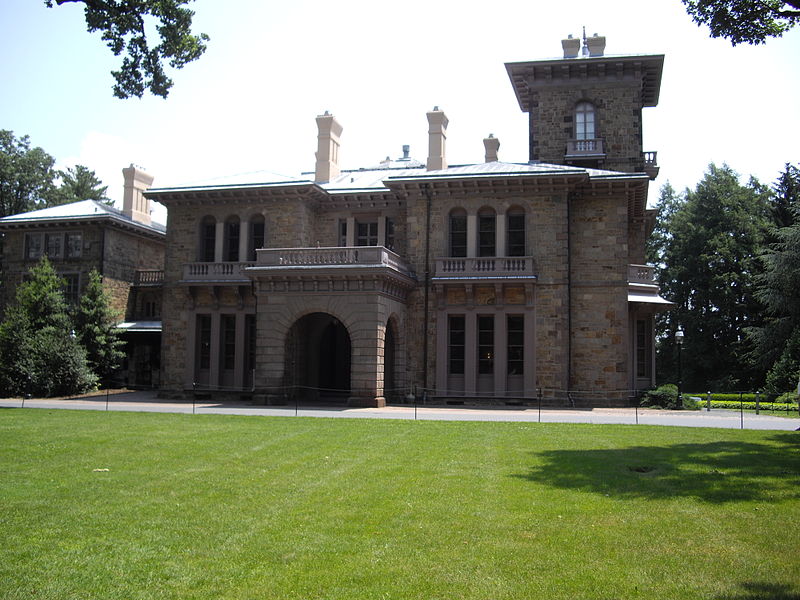 In 1902, Wilson was made president of Princeton University. Ellen Wilson undertook an historic restoration of the mansion provided to the university president and his family as a home, returning its interiors to a look which matched its Florentine style of 1849. Ellen Wilson also designed a breathtaking stained-glass window depicting Aristotle, which was then executed in the famous studios of Louis Comfort Tiffany. She also completely landscaped the grounds in the more informal style of the new century, with rambling flower beds, paths, cedar trees, fountains, sundial, rose garden and pergola. She came to know and entertain there celebrities such as captain of industry J.P. Morgan, author Mark Twain and African-American educator Booker T. Washington. In 1902, Wilson was made president of Princeton University. Ellen Wilson undertook an historic restoration of the mansion provided to the university president and his family as a home, returning its interiors to a look which matched its Florentine style of 1849. Ellen Wilson also designed a breathtaking stained-glass window depicting Aristotle, which was then executed in the famous studios of Louis Comfort Tiffany. She also completely landscaped the grounds in the more informal style of the new century, with rambling flower beds, paths, cedar trees, fountains, sundial, rose garden and pergola. She came to know and entertain there celebrities such as captain of industry J.P. Morgan, author Mark Twain and African-American educator Booker T. Washington.
Among her public activities, Ellen Wilson was a leader among the Princeton University Ladies Auxiliary, a group consisting of both female spouses of faculty and women faculty members. Their accomplishments included installation of a women’s division of the gymnasium and a medical infirmary of the first order, with nurses, maids and eventually a permanent, salaried physician. In her capacity as the university president’s spouse, Ellen Wilson prompted creation of a Princeton student code of honor, following her realization that there was a degree of student cheating occurring on examinations and other forms of testing.
 Ellen Wilson also suffered from long bouts of deep depression. She had many personal sorrows in the new century. Her brother Stockton continued to suffer from emotional and physical breakdowns and her other brother, his wife and son drowned in a ferry accident. Despite her strict Presbyterian upbringing and family history of those in the ministry, Ellen Wilson never a conventionally religious person and found little solace in prayer. Instead, she began to search for meaning in the logical-themed writings of German philosophers such as Hegel and Kant. Ellen Wilson also suffered from long bouts of deep depression. She had many personal sorrows in the new century. Her brother Stockton continued to suffer from emotional and physical breakdowns and her other brother, his wife and son drowned in a ferry accident. Despite her strict Presbyterian upbringing and family history of those in the ministry, Ellen Wilson never a conventionally religious person and found little solace in prayer. Instead, she began to search for meaning in the logical-themed writings of German philosophers such as Hegel and Kant.
She also endured what is known to have been an emotional, if not a sexual, affair of her husband with a witty friend Mary Hulbert Peck, a wealthy middle-aged Michigan mother estranged from her husband. Ellen Wilson was well aware of how dependent Wilson could be on the company and approval of women and the extreme loneliness he experienced during their separations.
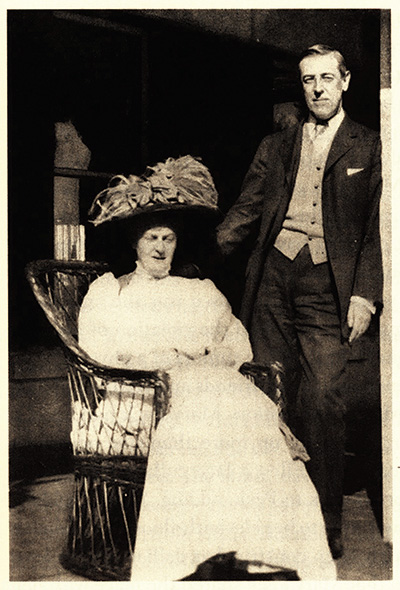 To counteract this, Ellen Wilson encouraged her husband to “go see some of those bright women….their appreciation of you ought to reassure you…” She surely knew nothing of his passionate letters to her, one of which he opened, “My precious one, my beloved Mary.” Wilson would later confess that his relationship with Mary Peck was “a contemptible error” and “madness of a few months,” which had made him feel “stained and unworthy.” Whether it ever went beyond the emotional and, if so, whether Ellen Wilson was aware of this is unknown. To counteract this, Ellen Wilson encouraged her husband to “go see some of those bright women….their appreciation of you ought to reassure you…” She surely knew nothing of his passionate letters to her, one of which he opened, “My precious one, my beloved Mary.” Wilson would later confess that his relationship with Mary Peck was “a contemptible error” and “madness of a few months,” which had made him feel “stained and unworthy.” Whether it ever went beyond the emotional and, if so, whether Ellen Wilson was aware of this is unknown.
It is known that a primary concern of Ellen Wilson’s in regard to her husband’s relationship with Mary Peck was the potential negative publicity it might someday have on his intended career move into public service. Supportive of her husband’s decision to run as New Jersey’s Democratic gubernatorial candidate in 1910, Ellen Wilson also displayed a natural instinct for the public relations aspects of political life. In her first public exposure through the national media, a profile of the Wilson family in Delineator magazine, her artistic abilities became the primary characteristic by which she was defined for the general public.
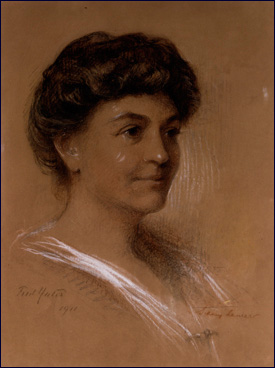 During the summer of 1905, Wilson had arranged a respite for their family at an artist’s colony in Old Lyme, Connecticut. Here, Ellen Wilson revived her professional aspirations as a painter. In 1908, while her husband went to Europe, Ellen Wilson returned to Old Lyme, taking instruction in landscape painting. By virtue of her work’s quality, she earned the honor of having her own studio from which to paint. During the summer of 1905, Wilson had arranged a respite for their family at an artist’s colony in Old Lyme, Connecticut. Here, Ellen Wilson revived her professional aspirations as a painter. In 1908, while her husband went to Europe, Ellen Wilson returned to Old Lyme, taking instruction in landscape painting. By virtue of her work’s quality, she earned the honor of having her own studio from which to paint.
It also afforded the future First Lady of the United States familiarity within the circle of artists who would form the core of American Impressionists, among them painter Childe Hassam. Although she now had other interests competing for her time as wife of the New Jersey governor, these sojourns to Old Lyme returned a sense of personal purpose to the life of Ellen Wilson, apart from her identity as a political spouse.
Following her husband’s gubernatorial election, she had the chance to fully develop her earlier interest in politics. Since there was no permanent gubernatorial mansion, Ellen Wilson had minimal social obligations, and used the extra time to focus entirely on the prospect of her husband’s eventual pursuit of the presidency. One great ally she made was Joseph Tumulty, his newly-appointed Irish Catholic private secretary who also functioned as press secretary.
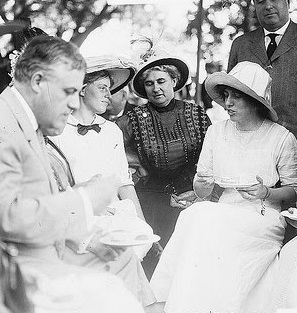 Through Tumulty, Ellen Wilson quickly learned the practical tactics employed in political public relations efforts and he came to discern her as having better political instincts than Wilson. She strongly urged her husband to desist from telling the press that he was not “thinking” about the presidency because, as she said, “it can’t be true,” and would make him vulnerable to accusations of deception. To back up her sensibility on the matter, she brought his attention to a New York Sun editorial which made the same case as she did. On another occasion, it was Ellen Wilson who arranged for the standard-bearer and Democratic presidential candidate William Jennings Bryan to meet with Wilson over dinner at their home. In doing this, Ellen Wilson helped secure an important establishment acceptance of Wilson as a serious presidential candidate in 1912. Through Tumulty, Ellen Wilson quickly learned the practical tactics employed in political public relations efforts and he came to discern her as having better political instincts than Wilson. She strongly urged her husband to desist from telling the press that he was not “thinking” about the presidency because, as she said, “it can’t be true,” and would make him vulnerable to accusations of deception. To back up her sensibility on the matter, she brought his attention to a New York Sun editorial which made the same case as she did. On another occasion, it was Ellen Wilson who arranged for the standard-bearer and Democratic presidential candidate William Jennings Bryan to meet with Wilson over dinner at their home. In doing this, Ellen Wilson helped secure an important establishment acceptance of Wilson as a serious presidential candidate in 1912.
Although it was an unsalaried and unofficial position, Ellen Wilson was named the chairman of the New Jersey Charities Aid Society. 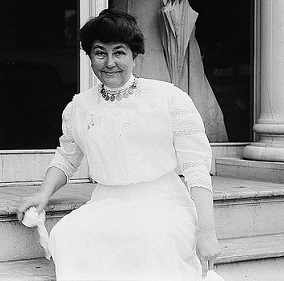 In that capacity, she made a tour of state institutions supporting veterans, orphaned or delinquent children, those in institutions for the mentally-ill, tuberculosis or with seizures. It gave her a first-hand grasp of the public need for social reform work and the growing sense of responsibility which both state and federal government and private industry were assuming. In that capacity, she made a tour of state institutions supporting veterans, orphaned or delinquent children, those in institutions for the mentally-ill, tuberculosis or with seizures. It gave her a first-hand grasp of the public need for social reform work and the growing sense of responsibility which both state and federal government and private industry were assuming.
Presidential Campaign and Inauguration:
In the months leading up to the Democratic presidential nomination of Woodrow Wilson in 1912, Ellen Wilson’s role in her husband’s campaign assumed greater importance. Before a group in Denver, the candidate personally admitted that it was Ellen Wilson who provided the literary and poetic material which he drew on heavily to artfully make a political point in his speeches, and for which he was being unfairly credited as an unusually poetic politician.
When powerful conservative forces in the Democratic Party used the Louisville Courier-Journal and the New York Sun to express resentment towards the progressivism of Wilson and also suggest he had profited from the Carnegie Foundation unfairly, it was Ellen Wilson who authored a detailed chronicle of events which defended her husband against the charges.
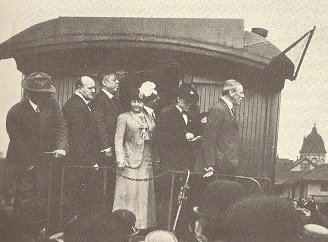 Three months before Wilson won the Democratic presidential nomination at the party convention in Baltimore the week of 25 June 1912, Ellen Wilson joined her husband on a whistlestop campaign speaking tour for numerous stops in her native state of Georgia. Although Mary Bryan had done so with her husband, during his presidential campaign speaking engagements from a train as the 1896 and 1900 Democratic candidate, Ellen Wilson became the first First Lady known to have made such an overtly political appearance in public. Three months before Wilson won the Democratic presidential nomination at the party convention in Baltimore the week of 25 June 1912, Ellen Wilson joined her husband on a whistlestop campaign speaking tour for numerous stops in her native state of Georgia. Although Mary Bryan had done so with her husband, during his presidential campaign speaking engagements from a train as the 1896 and 1900 Democratic candidate, Ellen Wilson became the first First Lady known to have made such an overtly political appearance in public.
As the several days of balloting at the Democratic Convention, House Speaker Champ Clark began to take the lead and increasingly appeared to be the imminent winner of the party’s nomination. On 29 June 1912, Wilson spoke by phone with one of his campaign managers at the convention and authorized withdrawal of his name from the roster of candidates. “You must not do it,” she convinced him. Several days later, through a remarkable forty-six ballots, Wilson won. In her first engaged interaction with the press corps, she admitted that she had feared he would lose the nomination, but expressed confidence that once nominated, he would succeed in the general election.
With the issue of granting women the equal right to vote having become a leading contention between the three 1912 presidential candidates (along with Wilson, there was incumbent Republican President William Howard Taft and former President Theodore Roosevelt), the press corps covering them sought to determine whether Ellen Wilson shared the viewpoint of her husband, who opposed it. The candidate’s spouse refused to publicly express her real views which would conflict with her husband. Ellen Wilson, however, did privately support suffrage. She had become convinced of a women’s right to vote during discussions with her daughter Jessie, a settlement house worker who observed he devastating societal affect of particularly denying poor and working-class women a voice in civic life.
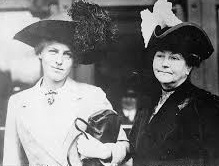 Ellen Wilson spent the duration of the summer and fall of 1912 at the summer home provided to New Jersey’s gubernatorial families in Sea Girt, on the Atlantic coast. During the campaign she took upon herself the personal task of addressing a rumor that she approved of women smoking cigarettes, then a contentious issue. She wrote her own statement of denial and even passed copies of it out to reporters, emphasizing that she believed her intense dislike of the habit might offend those who disagreed with her, even though she had once done so herself in a moment of humor. Unaccustomed to being the focus of national attention, Ellen Wilson sought to cope with the deluge of public mail which she received by hand-writing all her responses. Ellen Wilson spent the duration of the summer and fall of 1912 at the summer home provided to New Jersey’s gubernatorial families in Sea Girt, on the Atlantic coast. During the campaign she took upon herself the personal task of addressing a rumor that she approved of women smoking cigarettes, then a contentious issue. She wrote her own statement of denial and even passed copies of it out to reporters, emphasizing that she believed her intense dislike of the habit might offend those who disagreed with her, even though she had once done so herself in a moment of humor. Unaccustomed to being the focus of national attention, Ellen Wilson sought to cope with the deluge of public mail which she received by hand-writing all her responses.
Following her attendance at a performance of Macbeth, Ellen drew a general analogy to the need for wives to be ambitious in order to help their husbands succeed in attaining their reach for power, though she pointed out that the spouse’s ambition was not for herself personally but out of love and support of their husbands. She also observed that while such drive often came at the cost of a wife’s physical and emotional health, such women would willingly sacrifice their personal well-being rather than be left unsatisfied at the fact that their husband’s failed to capture the pinnacle of power. Perhaps this understanding is what led Ellen Wilson to write to former First Lady Edith Roosevelt, when her husband, then running as the Progressive Party candidate again Wilson, was shot and wounded.
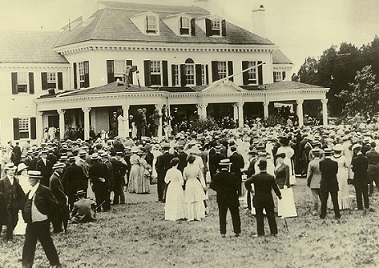 With the Election Day victory of Woodrow Wilson, Ellen Wilson assumed the management of moving them and their three adult daughters from Princeton to Washington, D.C. and taking occupancy of the White House. Ellen Wilson was also honored at a massive Women’s Democratic Club luncheon in New York and she granted several personal interviews with national magazines; the Ladies Home Journal even published two color plate prints of her landscapes. With the Election Day victory of Woodrow Wilson, Ellen Wilson assumed the management of moving them and their three adult daughters from Princeton to Washington, D.C. and taking occupancy of the White House. Ellen Wilson was also honored at a massive Women’s Democratic Club luncheon in New York and she granted several personal interviews with national magazines; the Ladies Home Journal even published two color plate prints of her landscapes.
In preparation for the new Administration, Ellen Wilson consulted with a fashion trend-setter in Princeton on a selection of appropriate clothing. She also played a key political advisory role to her husband, successfully urging him to name William Jennings Bryan as Secretary of State and Joseph Tumulty as White House Press Secretary, despite protest letters from bigots who feared the closeness of a Roman Catholic like him to the President of the United States.
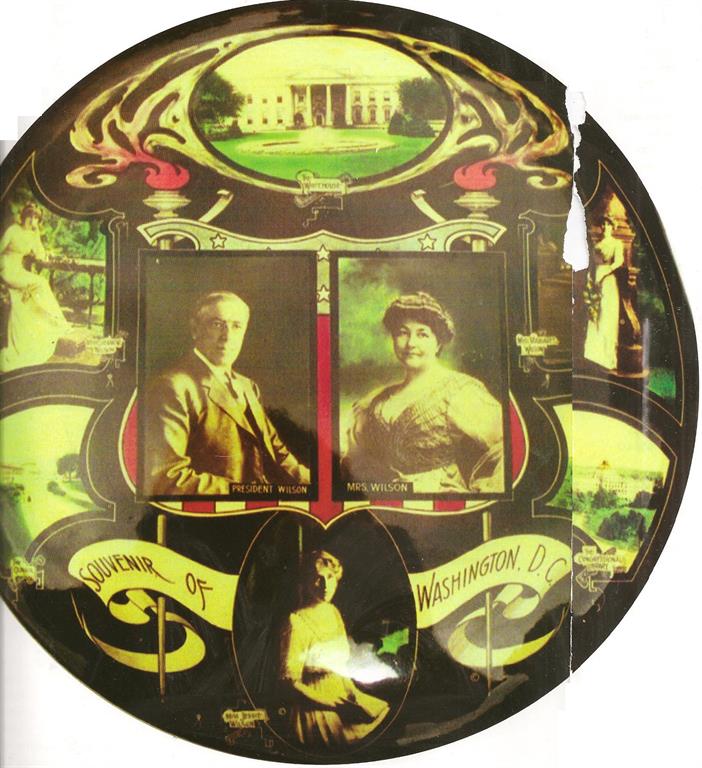 The outgoing First Lady Nellie Taft seemed to have played a significant role in advising her successor on the transition and what her future life in the executive mansion would entail. Following a tradition first set by the outgoing Edith Roosevelt who toured the incoming Nellie Taft through the White House, the latter guided the incoming Ellen Wilson through on 3 March 1913, a day before the Inauguration. The outgoing First Lady Nellie Taft seemed to have played a significant role in advising her successor on the transition and what her future life in the executive mansion would entail. Following a tradition first set by the outgoing Edith Roosevelt who toured the incoming Nellie Taft through the White House, the latter guided the incoming Ellen Wilson through on 3 March 1913, a day before the Inauguration.
Woodrow Wilson read his Inaugural Address to his wife and daughters before he delivered it in public. At the ceremony, wishing to hear him make the speech, the new First Lady arose from her chair to stand beneath the rostrum and look up to watch him and listen, seemingly oblivious to the thousands staring at her.
Although Ellen Wilson had looked forward to the traditional Inaugural Ball, Woodrow Wilson cancelled it as a needless extravagance. She hosted a post-inaugural luncheon, sat watching the Inaugural parade, hosted a large White House dinner for friends and family and then took in a firework display.
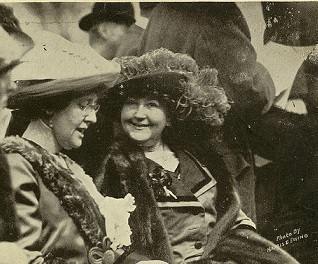
First Lady:
4 March 1913 – 6 August 1914
During the transition period following the election and before the inauguration, Ellen Wilson finally turned to her friend and husband’s cousin Helen Bones to aid her as a personal secretary, a role she continued in the White House [see biography of Helen Bones as surrogate First Lady below]. As First Lady, she also rehired Isabelle Hagner to be the Wilson Administration Social Secretary, asking her to repeat the official and federally-salaried position she first originated in 1901 for Edith Roosevelt. Hagner established her working office in the West Sitting Hall, in the family quarters, and it became a central focal point for the President, First Lady and their three adult daughters at the beginning and end of each day. Ellen Wilson made news when she went to a public photographer’s studio to pose for her formal portrait in a gown she had intended to wear to the cancelled Inaugural Ball, rather than request the photographer to capture her seated in the White House; this move symbolized an egalitarian gesture of the new Democratic Administration.
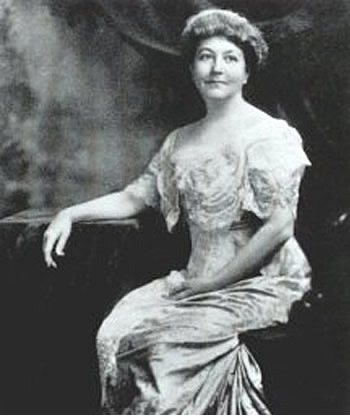 During her first full three months as First Lady, from March until June of 1913, Ellen Wilson hosted over forty White House receptions, with an average guest list of 600. Although both she and the President initially appeared on the receiving lines, it was the new First Lady who endured these to the end, at great expense to her health. As far as the slight derision the press suggested about her sense of fashion style, Ellen Wilson cared little. Bragging that she spent less than one thousand dollars a year on clothes, one newspaper columnist added sarcastically, “and she looks it.” During her first full three months as First Lady, from March until June of 1913, Ellen Wilson hosted over forty White House receptions, with an average guest list of 600. Although both she and the President initially appeared on the receiving lines, it was the new First Lady who endured these to the end, at great expense to her health. As far as the slight derision the press suggested about her sense of fashion style, Ellen Wilson cared little. Bragging that she spent less than one thousand dollars a year on clothes, one newspaper columnist added sarcastically, “and she looks it.”
In addition to the traditional roster of formal dinners during the social season honoring the various branches of government, Ellen Wilson also hosted a spring season of musicales and recitals. The many southern relatives of the President and First Lady filled the guest rooms of the White House for long stays at that time also.
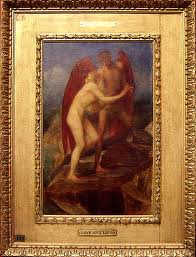 Ellen Wilson found escape from her social obligations by often attending the theater or the new silent “movies,” also beginning to be shown in public theaters. She further made visits to the local art galleries and museums. From the Corcoran Gallery, she had a famous canvas by artist George Watts, “Love and Life,” which pictured two nude women returned to the White House, which owned it. Edith Roosevelt had also displayed the painting in the private quarters, although Nellie Taft had sent it to the public museum. Ellen Wilson found escape from her social obligations by often attending the theater or the new silent “movies,” also beginning to be shown in public theaters. She further made visits to the local art galleries and museums. From the Corcoran Gallery, she had a famous canvas by artist George Watts, “Love and Life,” which pictured two nude women returned to the White House, which owned it. Edith Roosevelt had also displayed the painting in the private quarters, although Nellie Taft had sent it to the public museum.
Near her hometown of Rome, Georgia one Martha McChesney Berry had founded a special school to educate the children of impoverished white families who lived in the nearby mountains. As early as 1905, Ellen Wilson had been a supporter of the group, endowing a scholarship at the Berry School in honor of her late brother. She provided more direct aid and publicity to the “mountain women” of Tennessee and North Carolina in Appalachia by redecorating the blue and white presidential bedroom with furnishing fabrics and rugs hand-woven by the craftswomen, permitting it to be photographed in national publications. It helped to spur a brief but intense period of commerce for these women, who produced counterpanes, quilts, and other household furnishings. To aid fundraising efforts of the Kentucky Pine School, created to provide both traditional primary education and technical training for the poor Appalachian “Highland” children (a reference to their Scots-Irish heritage), Ellen Wilson assumed the role of honorary president for the Southern Industrial Association and in that capacity appeared at numerous public charity events in Washington.
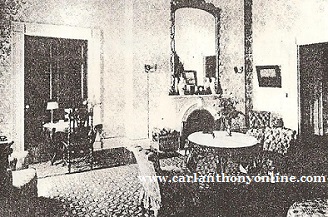 It was also Ellen Wilson who determined to expand the third floor or “attic” of the White House, as put in place by the 1902 renovation under Theodore Roosevelt into five bedrooms. Perhaps her most enduring contribution to the presidential mansion itself, though ephemeral, was the creation of the White House Rose Garden. She travelled back to Princeton, New Jersey with her landscaper to show him some of the work she had done there and intended to copy elements of at the White House. It included a fountain and marble statue of mythic Pan, one source claiming that Ellen Wilson chose the figurine of the boy to represent the son that she had always wished for. Although Ellen Wilson’s Rose Garden did not endure through the generations to the present-day one, it was placed in the same spot, outside the West Wing and thus established the tradition. She also created a garden flanking the east colonnade, at the site of the present-day Jacqueline Kennedy Garden, installing a lily pond stocked with goldfish. It was also Ellen Wilson who determined to expand the third floor or “attic” of the White House, as put in place by the 1902 renovation under Theodore Roosevelt into five bedrooms. Perhaps her most enduring contribution to the presidential mansion itself, though ephemeral, was the creation of the White House Rose Garden. She travelled back to Princeton, New Jersey with her landscaper to show him some of the work she had done there and intended to copy elements of at the White House. It included a fountain and marble statue of mythic Pan, one source claiming that Ellen Wilson chose the figurine of the boy to represent the son that she had always wished for. Although Ellen Wilson’s Rose Garden did not endure through the generations to the present-day one, it was placed in the same spot, outside the West Wing and thus established the tradition. She also created a garden flanking the east colonnade, at the site of the present-day Jacqueline Kennedy Garden, installing a lily pond stocked with goldfish.
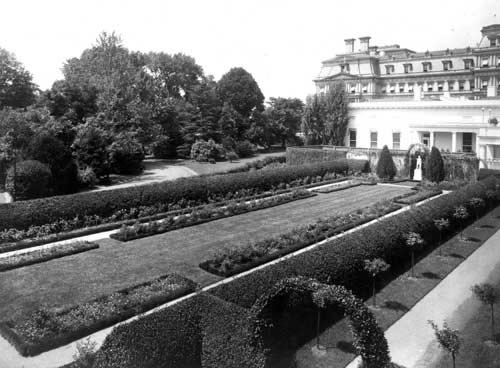 Ellen Wilson’s greatest legacy as First Lady was her commitment of service and support to a public welfare project intending to provide assistance to an otherwise ignored demographic. It was an effort she began eighteen days after becoming First Lady, when on 22 March 1913, she had a meeting with Charlotte Everett Wise Hopkins, the chairperson of the Women’s Committee of the National Civic Foundation’s Washington branch. A civic activist in Washington for several generations, Hopkins had first successfully engaged a First Lady in local issues when she convinced Frances Cleveland to support an annual charity Christmas party for the children of the African-American working-class in the nation’s capital city. The widespread and deplorable housing of this same demographic was the concern of Charlotte Hopkins when she convinced Ellen Wilson to join her effort to reform this problem. Ellen Wilson’s greatest legacy as First Lady was her commitment of service and support to a public welfare project intending to provide assistance to an otherwise ignored demographic. It was an effort she began eighteen days after becoming First Lady, when on 22 March 1913, she had a meeting with Charlotte Everett Wise Hopkins, the chairperson of the Women’s Committee of the National Civic Foundation’s Washington branch. A civic activist in Washington for several generations, Hopkins had first successfully engaged a First Lady in local issues when she convinced Frances Cleveland to support an annual charity Christmas party for the children of the African-American working-class in the nation’s capital city. The widespread and deplorable housing of this same demographic was the concern of Charlotte Hopkins when she convinced Ellen Wilson to join her effort to reform this problem.
 Rather than simply hear about the problem that these residents who lived in crowded shacks and shanties, cramped into dirty and dark alleys in dwellings that often had no plumbing, the First Lady went to visit them herself on 25 March 1913, following a visit to a hospital for the terminally ill. Led by Hopkins, Ellen Wilson then visited four of the slum alleys, Logan Court, Neil Place, Goat Tree and Willow Tree. Shortly thereafter, she joined a social worker in a tour of newly-built model homes for low-income families, over one hundred two-family structures each of which had from two to four rooms, and were built with full utilities. These were built by the private Sanitary Housing Company; as a sign of not only her public but private commitment to the effort, the First Lady became a stockholder, investing personal funds in the endeavor. Rather than simply hear about the problem that these residents who lived in crowded shacks and shanties, cramped into dirty and dark alleys in dwellings that often had no plumbing, the First Lady went to visit them herself on 25 March 1913, following a visit to a hospital for the terminally ill. Led by Hopkins, Ellen Wilson then visited four of the slum alleys, Logan Court, Neil Place, Goat Tree and Willow Tree. Shortly thereafter, she joined a social worker in a tour of newly-built model homes for low-income families, over one hundred two-family structures each of which had from two to four rooms, and were built with full utilities. These were built by the private Sanitary Housing Company; as a sign of not only her public but private commitment to the effort, the First Lady became a stockholder, investing personal funds in the endeavor.
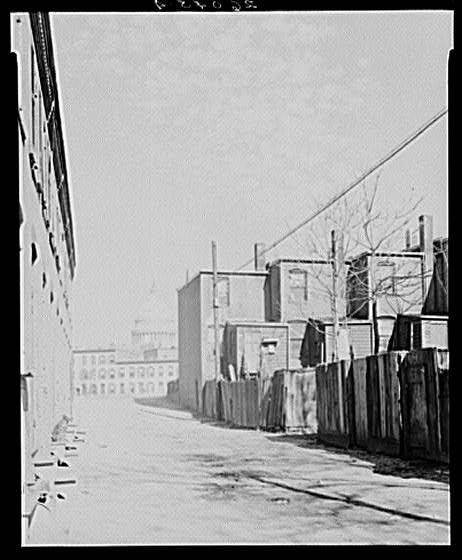 Although Charlotte Hopkins continued in her role as chairperson of the Women’s Committee of the National Civic Foundation’s Washington branch, Ellen Wilson assumed the title of honorary chair. There were several further tours she made to both the alley dwellings and the model homes, now with members of Congress and reform-minded political spouses accompanying her, including a young Eleanor Roosevelt, then the wife of the Assistant Navy Secretary. Civic leaders and philanthropists worked with members of the House and Senate to form a “Committee of Fifty” to begin addressing the problem with federal legislation. Ellen Wilson invited them for an initial White House meeting, where the Secretary of State pointed out that, “The fact that the wife of the President…lending support to the movement is enough” to set it off with great potential for success. Within eleven months legislation had been drafted for federal funding to clear the alley dwellings. However, a major failing of the bill was that it lacked funding for building new housing for those who would be displaced, no matter how poor the housing, the assumption being that the units that were slated for building by the private Sanitary Housing Company would suffice. Although Charlotte Hopkins continued in her role as chairperson of the Women’s Committee of the National Civic Foundation’s Washington branch, Ellen Wilson assumed the title of honorary chair. There were several further tours she made to both the alley dwellings and the model homes, now with members of Congress and reform-minded political spouses accompanying her, including a young Eleanor Roosevelt, then the wife of the Assistant Navy Secretary. Civic leaders and philanthropists worked with members of the House and Senate to form a “Committee of Fifty” to begin addressing the problem with federal legislation. Ellen Wilson invited them for an initial White House meeting, where the Secretary of State pointed out that, “The fact that the wife of the President…lending support to the movement is enough” to set it off with great potential for success. Within eleven months legislation had been drafted for federal funding to clear the alley dwellings. However, a major failing of the bill was that it lacked funding for building new housing for those who would be displaced, no matter how poor the housing, the assumption being that the units that were slated for building by the private Sanitary Housing Company would suffice.
Ellen Wilson has, however, been incorrectly credited for an effort actually initiated by her immediate predecessor Nellie Taft, with a progressive reform largely affecting African-American residents of Washington, D.C. In March of 1912, the press reported one of the first instances of a First Lady’s overt political influence, chronicling how Mrs. Taft successfully implored President Taft to issue a presidential order establishing the first health and safety regulations in the federal workplace. Nellie Taft had learned of the lack of adequate restrooms, lunchrooms, fire escapes, plumbing, electric lighting, sunlight and fresh-air windows and venting by visiting executive departmental buildings with Charlotte Hopkins of National Civic Foundation. Although the Taft Administration initiative had been ordered into effect before it ended in March of 1913, the new regulations were not put into place as the new Wilson Administration ensued.
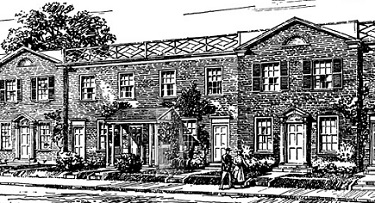 Although she was not a federal official, Charlotte Hopkins acted as an unofficial custodian of the promised reform and wisely brought the federal government’s failure to the attention of the new First Lady. Led by Hopkins at the end of October 1913, Ellen Wilson made sudden, unannounced inspections of the Government Printing Office and the Postal Department and saw for herself what was termed “unsanitary conditions” under which lower-wage government clerks toiled, a large majority of who were women and also African-American. Despite the First Lady taking the matter up directly with Postmaster General Albert S. Burleson, he failed to take action. A visibly angered Ellen Wilson raised the problem with the President’s private adviser Edmund House at a luncheon and he finally assured her he would see to the order being carried out. Although she was not a federal official, Charlotte Hopkins acted as an unofficial custodian of the promised reform and wisely brought the federal government’s failure to the attention of the new First Lady. Led by Hopkins at the end of October 1913, Ellen Wilson made sudden, unannounced inspections of the Government Printing Office and the Postal Department and saw for herself what was termed “unsanitary conditions” under which lower-wage government clerks toiled, a large majority of who were women and also African-American. Despite the First Lady taking the matter up directly with Postmaster General Albert S. Burleson, he failed to take action. A visibly angered Ellen Wilson raised the problem with the President’s private adviser Edmund House at a luncheon and he finally assured her he would see to the order being carried out.
Why Ellen Wilson did not bring the problem directly to the President is uncertain. The dearth of information on this episode may suggest the more sensitive issue of racial segregation in the federal workplace being at the heart of the matter. President Wilson stunned and angered African American leaders who had supported his election when, instead of reducing and eradicating the separation of black and white federal employees, he upheld what was known as “Jim Crow.” This became all the more dramatically visible when the work areas of the federal buildings were reconfigured to conform to the new health and safety standards so vigorously pushed by Ellen Wilson.
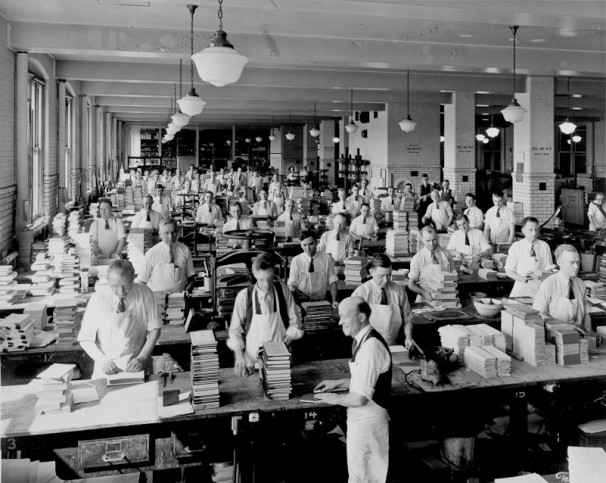 Thus, some have placed blame for the Wilson Administration’s racial segregation policy on the First Lady. However, closer examination of some evidence suggests this is, at the least, partially unfair if not entirely untrue. It was in August of 1913 that the African American media and political leaders leveled angry criticism of Wilson, even personally confronting him, over the enforced segregation which was already being initiated. Ellen Wilson did not assume the crusade begun by her predecessor until two months later. Furthermore, while eviscerating the President for his policy, the leading African-American newspaper of the capital city, The Washington Bee, highly praised the First Lady for her genuine concern for the lives of those black citizens of Washington who were living and working in sub-standard conditions. There is no evidence that Ellen Wilson encouraged Jim Crow and according to later observations by her daughter Jessie, Ellen Wilson felt it her duty to help provide every opportunity for educational, employment and economic success of African-Americans. However, she maintained a traditional southerner’s view that the races should be separated in “social” arenas, although she did not include the workplace. Thus, some have placed blame for the Wilson Administration’s racial segregation policy on the First Lady. However, closer examination of some evidence suggests this is, at the least, partially unfair if not entirely untrue. It was in August of 1913 that the African American media and political leaders leveled angry criticism of Wilson, even personally confronting him, over the enforced segregation which was already being initiated. Ellen Wilson did not assume the crusade begun by her predecessor until two months later. Furthermore, while eviscerating the President for his policy, the leading African-American newspaper of the capital city, The Washington Bee, highly praised the First Lady for her genuine concern for the lives of those black citizens of Washington who were living and working in sub-standard conditions. There is no evidence that Ellen Wilson encouraged Jim Crow and according to later observations by her daughter Jessie, Ellen Wilson felt it her duty to help provide every opportunity for educational, employment and economic success of African-Americans. However, she maintained a traditional southerner’s view that the races should be separated in “social” arenas, although she did not include the workplace.
Jessie Wilson Sayre’s observations about her mother’s racial views emerged in a private interview she granted in her Cambridge, Massachusetts home on December 1, 1925, the transcript of which is now in the collections of the Library of Congress. In it, she stated explicitly: “Mrs. Wilson felt much more strongly about the color line than did Mr. Wilson. She had far more of the old southern feelings, with its curious paradox of a warm personal liking for the negroes, combined with an instinctive hostility to certain assumptions of equality.”
Ellen Wilson’s political influence on the President is believed to have been less about her raising issues with him than he seeking her opinion. According to their daughter Nell, he reviewed not only all of his important political speeches with her but “every important move.” His Treasury Secretary believed that Ellen Wilson was “the soundest and most influential” of the President’s personal advisers. Like Ida McKinley, Ellen Wilson did successfully help place several individuals who sought her intercession in their gaining federal positions of postmasters and postmistresses. She was unsuccessful in her effort to coax the President’s choice for Ambassador to Germany to accept the offer of the position. She seemed to have been a positive reinforcement behind his decision to become the first chief executive since the Federal Era to personally deliver the presidential “state of the union” report as a speech before Congress, joking that it was just the sort of innovation that former President Theodore Roosevelt would have done, “if he had thought of it.”
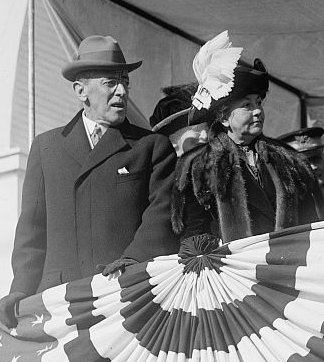 Capable of grasping the complexities of the currency, banking, tax, tariff and anti-trust reforms being initiated by the President, Ellen Wilson was kept closely apprised by him in letters during the summer of 1913 not only of the progress of his proposed changes to tariff rates but also the threat of conflict on the U.S.-Mexican border resulting from Mexican dictator General Victoriano Huerta, who was agitating internal strife in his country. “Perhaps it would save us trouble in the long run to give them arms and let them exterminate each other if they so prefer,” she half-jokingly suggested to him in a series of written responses. “A plague on the Monroe Doctrine! Lets throw it overboard! All the European nations have interests and citizens there as well as we, and if we could all unite in bringing pressure upon Huerta we could bring even that mad brute to hear reason.” Capable of grasping the complexities of the currency, banking, tax, tariff and anti-trust reforms being initiated by the President, Ellen Wilson was kept closely apprised by him in letters during the summer of 1913 not only of the progress of his proposed changes to tariff rates but also the threat of conflict on the U.S.-Mexican border resulting from Mexican dictator General Victoriano Huerta, who was agitating internal strife in his country. “Perhaps it would save us trouble in the long run to give them arms and let them exterminate each other if they so prefer,” she half-jokingly suggested to him in a series of written responses. “A plague on the Monroe Doctrine! Lets throw it overboard! All the European nations have interests and citizens there as well as we, and if we could all unite in bringing pressure upon Huerta we could bring even that mad brute to hear reason.”
While the President largely remained in Washington, Ellen Wilson spent her first summer as First Lady at an artist’s colony in Cornish, New Hampshire. There she devoted her time and attention to her personal ambitions as an artist, joining a circle of prominent American artists who worked in different mediums, like illustrator Maxfield Parrish, architect Charles Adams Platt and sculptor Bessie Vonnoh.
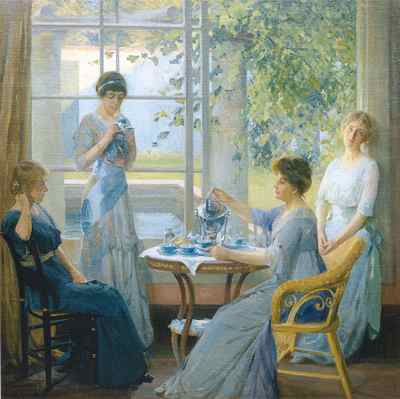 While in residence at the summer colony, Ellen Wilson joined a club of artists and when it was her turn to lead a group discussion, chose the question to be debated, “How can we best promote a fuller and more general appreciation of American art?” To the suggestion that the American federal government should use France’s model and begin to systematically promote and collect works of national importance by creating a department of the arts, the First Lady mused that “the Congressmen who would take that view….[are] not yet born.” While in residence at the summer colony, Ellen Wilson joined a club of artists and when it was her turn to lead a group discussion, chose the question to be debated, “How can we best promote a fuller and more general appreciation of American art?” To the suggestion that the American federal government should use France’s model and begin to systematically promote and collect works of national importance by creating a department of the arts, the First Lady mused that “the Congressmen who would take that view….[are] not yet born.”
A year before her husband had been elected President, Ellen Wilson submitted one of her paintings under an assumed name for consideration in a public exhibition at New York’s MacBeth Gallery on Fifth Avenue. Winning a place in the art show based on its merit alone, the gallery owner William MacBeth became her art agent and an important factor in encouraging her to begin publicly displaying her work.
Just days before her husband was elected President, Ellen Wilson’s landscape Autumn was entered in a juried show, the twenty-fifth annual Art Institute of Chicago exhibition and won a place there, before being shown at Indianapolis’s Herron Art Institute.
As she was transitioning into the White House during the late winter of 1913, Ellen Wilson’s canvases The Old Lane and Autumn Day were hung at the Pennsylvania Academy of Fine Arts annual exhibition. She joined Pen and Brush, an organization of professional women artists and writers and accepted the prestigious invitation to join what is now the National Association of Women Artists.
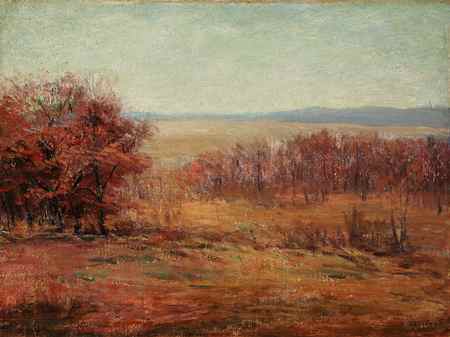 Perhaps the greatest professional accomplishment reached by a woman just as she was about to become First Lady was Ellen Wilson’s first one-woman art show. Fifty of her landscapes were publicly displayed in Philadelphia’s Arts and Crafts Guild, half of them selling. The New York Times reviewed her work favorably. Following her 1913 summer work in Cornish, New Hampshire, the First Lady made a private sale of four canvases, loaned one to a Cleveland art exposition and had five of her recently-completed oil landscapes were chosen for Association of Women Painters and Sculptors exhibition in New York in the autumn 1913, resulting in three being sold. Ellen Wilson donated her work income to the Berry School for mountain children. Perhaps the greatest professional accomplishment reached by a woman just as she was about to become First Lady was Ellen Wilson’s first one-woman art show. Fifty of her landscapes were publicly displayed in Philadelphia’s Arts and Crafts Guild, half of them selling. The New York Times reviewed her work favorably. Following her 1913 summer work in Cornish, New Hampshire, the First Lady made a private sale of four canvases, loaned one to a Cleveland art exposition and had five of her recently-completed oil landscapes were chosen for Association of Women Painters and Sculptors exhibition in New York in the autumn 1913, resulting in three being sold. Ellen Wilson donated her work income to the Berry School for mountain children.
Although Ellen Wilson was angered when she was allegedly quoted incorrectly by one newspaper saying,”I intend never entirely to desert my art,” she did shatter a precedent by becoming the first First Lady who managed to also simultaneously pursue her profession. There was no criticism of her doing so either in the press or public mail. Although seemingly judged on its quality, one of her submitted canvases failed to qualify for the nationally prestigious Carnegie International annual exhibit, yet when she placed in the National Academy of Design exhibition in December of 1913, some fellow artists charged that her work’s entry was based not on merit but “favoritism.”
In the White House, Ellen Wilson also created a private space for herself among the renovated rooms of the third floor, setting up her easel and paints there and establishing it as her private art studio. By the time of her return to the White House in the fall of 1913, however, she had less time to take full advantage of the space.
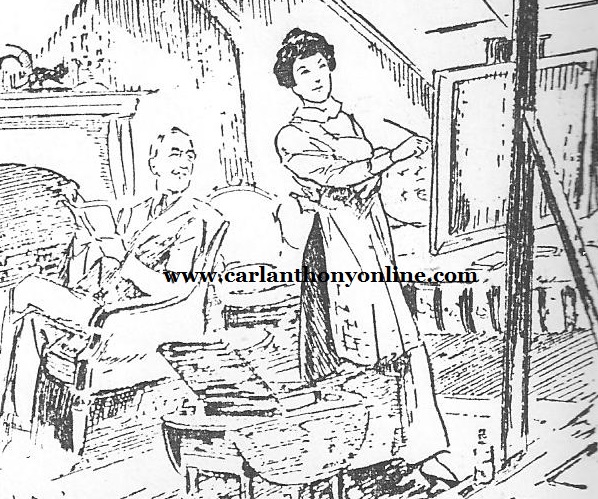
Woodrow Wilson was both supportive and encouraging of his wife’s professional pursuit but Ellen Wilson still made his well-being her priority. She rarely allowed herself to be separated from him and, as she had done throughout their marriage, was highly attuned to his mental and physical health, and his inclination to suffer tremendous stress from work. She encouraged of all his political accomplishments, being certain, for example, to join him in the Oval Office to witness his signing of the Federal Reserve Bill, which he considered an important accomplishment of his banking reform agenda. On the increasingly contentious issue of women’s suffrage, Ellen Wilson assumed a neutral position, welcoming activists who both supported and opposed it, although her husband refused to endorse it and her daughters favored it.
During her tenure as First Lady, Ellen Wilson assumed responsibility for planning of the 25 November 1913 East Room wedding of her daughter Jessie to Francis Sayre and also the 7 May 1914 wedding of her daughter Nell to the twenty-six years older widower and Treasury Secretary William McAdoo in the Blue Room. Although these events were of public interest, neither received the level of press coverage given to Alice Roosevelt’s 1906 White House wedding to Congressman Nicholas Longworth, a fact attributable to both Roosevelt’s comparative youth and highly visible and defined public persona.
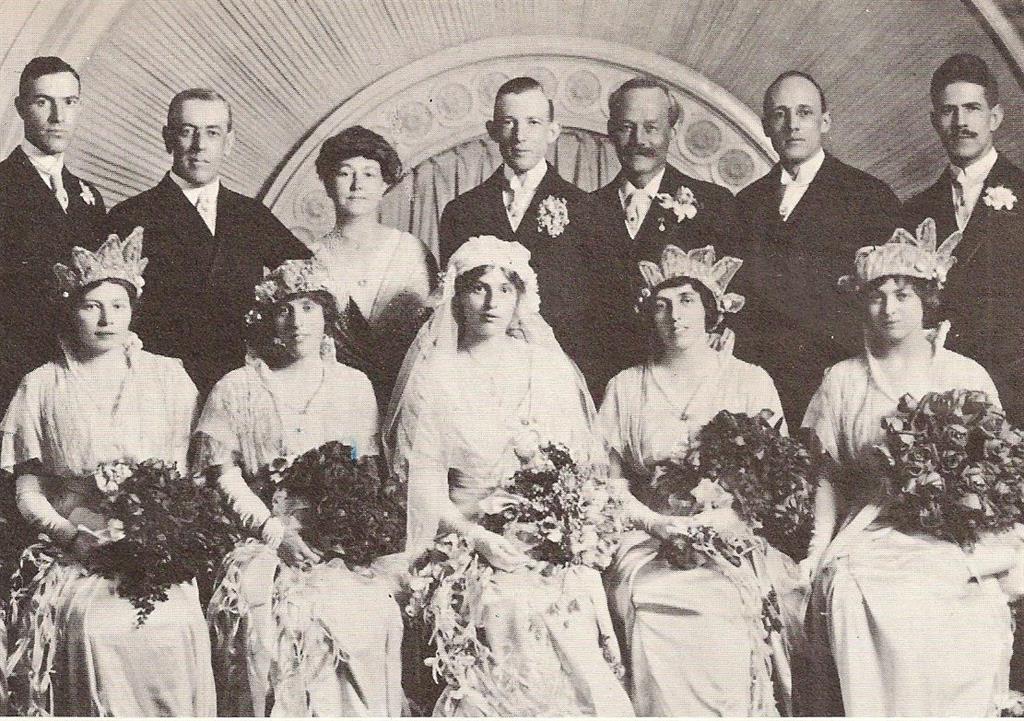
Initially, it was believed that Ellen Wilson’s sudden loss of energy was due to her year of intense activity, culminating in the planning of the weddings and what her husband called an “ugly fall,” on 1 March 1914. It left her bruised and pained, as well as shocked. Two months later she reflected on the toll of life as a First Lady: “Nobody who has not tries can have the least idea of the exactions of life here and of the constant nervous strain of it all, - the life, combined with the constant anxiety about Woodrow, his health, the success of his legislative plans, etc. etc; If I could only sleep as he does I could stand twice as much.” It is unclear at what point she may have learned that she had a terminally-ill kidney disease known as Bright’s Disease but she kept the news from her family. Dr. Cary Grayson moved into the White House on 23 July 1914, knowing this, but it was not until 3 August 1914, that the President’s physician informed him about the true nature of his wife’s increasingly painful ailment. Two days later, the President permitted a press release to fully inform the public of her terminal condition. On her deathbed, she told the President she could “go away more cheerfully” if she knew that the alley clearance bill, still pending in Congress, would pass; word of this was sent to Capitol Hill and her request was immediately granted. Her last spoken words were to ask her physician to “promise me that you will take good care of my husband.”
Death:
6 August 1914
The White House
Burial:
Myrtle Hill Cemetery
Rome, Georgia
Ellen Wilson became the third presidential wife who died in the White House, following Letitia Tyler in 1842 and Caroline Harrison in 1892. Initially, the First Lady’s remains were rested on her White House bed. Four days after her death, a private funeral service was held for her in the East Room of the White House. Floral arrangements from around the world lined the entire east and west walls of the long room.
Her coffin was then escorted by her family on the train journey to her native Georgia, to the Rome cemetery where the late First Lady’s parents were buried.
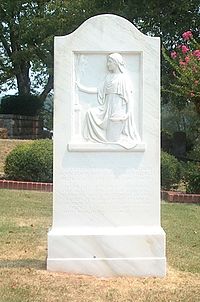 For a full year after her burial, the grave site of the deceased First Lady remained unmarked with a headstone. Although this was not an unusual circumstance, her national status as a presidential spouse drew press attention to this fact. It was used as a point of public disapproval over the fact that her widowed husband had already begun publicly dating the woman who would become his second wife before a marker had been placed on the final resting place of his first wife. For a full year after her burial, the grave site of the deceased First Lady remained unmarked with a headstone. Although this was not an unusual circumstance, her national status as a presidential spouse drew press attention to this fact. It was used as a point of public disapproval over the fact that her widowed husband had already begun publicly dating the woman who would become his second wife before a marker had been placed on the final resting place of his first wife.
The deceased First Lady was honored by an Ellen Wilson Memorial Fund, established to create financial support for the education of impoverished children of white Appalachian families.
Although the U.S. Congress did ensure passage of an act to clear the unsanitary and unsafe slum dwellings to honor the last request of the dying First Lady, the federal funding priorities brought on with the onset of World War I essentially prevented any substantive action from taking place. In later years, a low-income housing project to provide shelter for many of the families displaced by the act was named in her honor.
MARGARET WOODROW WILSON
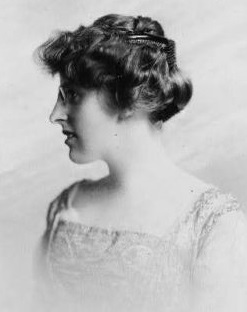 While the widower President Wilson was intensely close to all three of his daughters, his second and third, Nell and Jessie, following their White House weddings, established households of their own with their husbands, the former in Williamstown, Massachusetts the latter in Washington, D.C. It thus fell to his eldest and only unmarried daughter Margaret Wilson to become his personal companion in the immediate weeks of intense grief following her mother’s death in August of 1914. While the widower President Wilson was intensely close to all three of his daughters, his second and third, Nell and Jessie, following their White House weddings, established households of their own with their husbands, the former in Williamstown, Massachusetts the latter in Washington, D.C. It thus fell to his eldest and only unmarried daughter Margaret Wilson to become his personal companion in the immediate weeks of intense grief following her mother’s death in August of 1914.
From August of 1914 until December of 1915, Margaret Wilson served as primary female figure of the Wilson Administration. Similar to what was done during the Jefferson, Monroe, Jackson, Tyler, Taylor, Pierce, and Andrew Johnson Administrations, the various First Lady roles typically assumed by one presidential spouse were shared between Margaret Wilson and her first cousin, once removed Helen Bones.
Following the December 1915 remarriage of her widowed father, the President’s new wife Edith Bolling Galt Wilson assumed the First Lady role but Margaret Wilson shared many public duties with her and a companion, confidante role to him. She continued to play a central role in his presidency before, during and after World War I, as well as his post-presidential life.
Birth:
16 April 1886
Gainesville, Georgia
Father and Mother:
See the Ellen Wilson biography above.
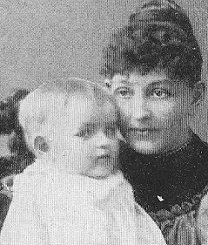 As the birth of her first child Margaret approached, Ellen Wilson, longing for maternal comfort and guidance, decided to temporarily relocate to the South Bradford Street home of her late mother’s sister, her aunt Louisa Hoyt Brown. She was also a mid-wife, in the northern Georgia town of Gainesville. It has often been mistakenly assumed that her middle name was chosen to honor her father; however, “Woodrow” was his legal middle name, his given name being Thomas. Her middle name of “Woodrow” was chosen to commemorate her parental grandmother’s family. As the birth of her first child Margaret approached, Ellen Wilson, longing for maternal comfort and guidance, decided to temporarily relocate to the South Bradford Street home of her late mother’s sister, her aunt Louisa Hoyt Brown. She was also a mid-wife, in the northern Georgia town of Gainesville. It has often been mistakenly assumed that her middle name was chosen to honor her father; however, “Woodrow” was his legal middle name, his given name being Thomas. Her middle name of “Woodrow” was chosen to commemorate her parental grandmother’s family.
Woodrow and Ellen Wilson forged especially close relationships with their three daughters, and the rise of her father’s career became as important to even a young Margaret Wilson as it was to her mother. As the eldest, Margaret Wilson was protective and defensive of her two younger sisters. She also showed physical bravery, often dangerously climbing trees, rocks, and even the rising structure of what would become the family home to the alarm of her younger sisters. While always close to them both, Nell Wilson described Margaret as possessing a “passion for being alone.”
Independent, exceptionally intelligent, yet also highly self-conscious and sensitive to others, her mother’s biographer described Margaret Wilson as “disarmingly literal.” Being home-schooled by her mother, Margaret Wilson was introduced at an unusually early age to the classics, Shakespeare, and Latin. Her mother also read poetry aloud to her and her sisters, while their father often repeated theatrical monologues, did verbal impressions in different dialects and sang. Early on in life, she displayed a gift for singing in alto and also speaking with pleasant, distinct diction. The Wilson daughters were also aided by German governess Clara Bohn who taught the girls to passably speak and understand her native tongue.
Siblings:
See the Ellen Wilson biography above.
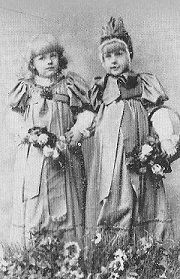 Religion: Religion:
Presbyterian, Hindu. Ellen Wilson taught her daughters the Presbyterian catechism, and rewarded their repetition of learned lessons with a copy of the Bible. Even when they were too young to yet sit still in church, their mother walked them to the front of it as Sunday services were getting out. Margaret Wilson, however, decided as a young woman that she did not want to formally embrace the traditional faith of her family and would not receive communion.
Education:
Mrs. Scott’s private school, Princeton, New Jersey, 1898-1899
When the governess of the Wilson daughters began teaching language at this small, private school run by a married Princeton women, the girls enrolled there and were found to be the most prepared and educated among the small student body.
Miss Fine’s private school, Princeton, New Jersey, 1899-1902
A co-educational institution founded by Wellesley College graduate Margaret Fine, this school of high academic standards later became famous as Princeton Day School. Margaret Wilson and her sisters completed their secondary school education here, which was located walking distance from their home.
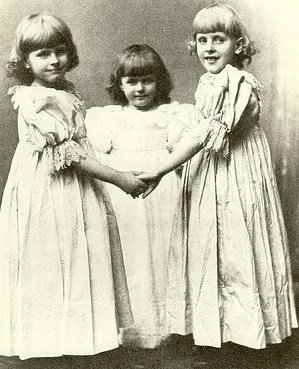 Women’s College of Baltimore (Goucher College), Baltimore, Maryland, 1903-1905.Margaret Wilson approached her preparation for college entrance exams with an intensity that left her with “such a headache,” as she studied for the language portion. She then entered a “state of excessive mortification” at the idea of failing; her grades were passable enough that she was enrolled with her sister Jessie in the fall semester in 1903. It is unclear precisely what course of study was pursued by Margaret Wilson during two years of college. It is known, however, that she studied piano at voice during this time at the Peabody Institute of Music, also in Baltimore, Maryland. Women’s College of Baltimore (Goucher College), Baltimore, Maryland, 1903-1905.Margaret Wilson approached her preparation for college entrance exams with an intensity that left her with “such a headache,” as she studied for the language portion. She then entered a “state of excessive mortification” at the idea of failing; her grades were passable enough that she was enrolled with her sister Jessie in the fall semester in 1903. It is unclear precisely what course of study was pursued by Margaret Wilson during two years of college. It is known, however, that she studied piano at voice during this time at the Peabody Institute of Music, also in Baltimore, Maryland.
However, as a letter of 25 February 1905 by Ellen Wilson revealed, Margaret Wilson endured a “nervous condition,” which had her mother rush to her side. Three medical specialists treating her all agreed that she should not endure the process of submitting to any further academic examinations during the rest of the spring term, since her preparation for them provoked such severe anxiety in her that it led to physical deterioration. “She has been a nervous child all her life and is evidently unfitted by temperament to take a full college course,” her mother wrote at the time.
In an effort to distract her sense of failure at school while also stimulate her natural curiosity, Margaret Wilson’s parents sent her on her first European trip that summer, allowing her to explore England, Scotland, France, Italy and Germany. Upon her return in October, however, Ellen Wilson wrote that the trip had failed to return Margaret Wilson to a strong mental and physical state.
As for returning to complete her education, Margaret Wilson wrote her sister Jessie, “I don’t want to a bit.” Her plan was to continue studying voice at the Peabody Conservatory. From letters written to close friends and relatives by both of her parents, and an absence of any record of her life during the period between October 1905 and April 1906 it was clear that Margaret Wilson suffered such a severe “nervous collapse” that it resulted in a physical debility, perhaps a mild version of the stroke her own father suffered as President thirteen years later.
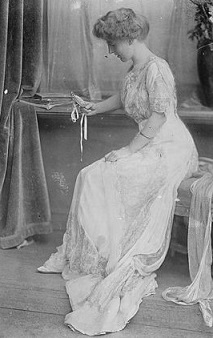 By April of 1906, her father was relieved to report that she “looks and seems better than we have seen her look in several years…” Certainly whatever illness Margaret Wilson endured it was not clearly apparent to those she met, for she attended an historic luncheon that December hosted by the Wilsons for the President and his wife, thus bringing together three women who had been, were and would be First Ladies: Ellen Wilson, Edith Roosevelt and Frances Cleveland, a Princeton resident and friend of the Wilsons. By April of 1906, her father was relieved to report that she “looks and seems better than we have seen her look in several years…” Certainly whatever illness Margaret Wilson endured it was not clearly apparent to those she met, for she attended an historic luncheon that December hosted by the Wilsons for the President and his wife, thus bringing together three women who had been, were and would be First Ladies: Ellen Wilson, Edith Roosevelt and Frances Cleveland, a Princeton resident and friend of the Wilsons.
As her father’s career rose through academia and then into state and national politics, Margaret Wilson began her early life first in Pennsylvania and then Connecticut but spent most of it in Princeton, New Jersey where he went from professor to university president.
By the time her father was elected governor of New Jersey in 1910, Margaret Wilson was spending much of her time in music and voice lessons in New York City, where she preferred to live during the weekdays. Having what her sister called “her own ideas,” she “seldom asked for advice” from her parents or sisters.
Campaign and Inauguration:
 During her father’s bid for the Democratic presidential campaign at the convention in Baltimore, Margaret Wilson was especially engaged in following each ballot but assumed no prominent role during the general campaign. The family was startled, however, at the perception of Margaret Wilson conveyed to the public by press photographs as, in the words of her sister, “the grotesque proportions of a militant suffragette.” While disappointed that her father had cancelled the Inaugural Ball, Margaret Wilson still appeared in a new blue outfit and the gift of a seed pearl necklace from her parents, although the public and the press had a difficult time in initiating identifying the individual Wilson sisters. During her father’s bid for the Democratic presidential campaign at the convention in Baltimore, Margaret Wilson was especially engaged in following each ballot but assumed no prominent role during the general campaign. The family was startled, however, at the perception of Margaret Wilson conveyed to the public by press photographs as, in the words of her sister, “the grotesque proportions of a militant suffragette.” While disappointed that her father had cancelled the Inaugural Ball, Margaret Wilson still appeared in a new blue outfit and the gift of a seed pearl necklace from her parents, although the public and the press had a difficult time in initiating identifying the individual Wilson sisters.
First Daughter
During the seventeen months that her mother lived as a presidential spouse, Margaret Wilson was also highly active, already serving as an aide to the First Lady. Living in the White House in a bedroom suite apart from her parents and sisters, she occupied the large suite at the east end of the second floor in what is today known as the Lincoln Bedroom. Furnished in blue, she kept her baby grand piano in a corner of the room and often entertained friends and her family by playing and singing to them there.
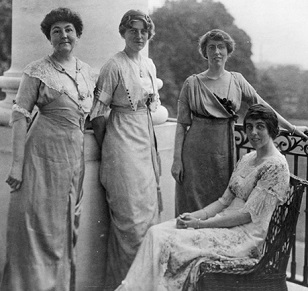 For activities which took place outside of the White House, Margaret Wilson maintained her own separate public schedule as arranged by the Social Secretary Belle Hagner, who insisted that she not appear at the same events where her two sisters might be in attendance, so that a far larger number of invitations to charity events extended to the presidential family could be accepted. Margaret Wilson had some difficulties in adjusting to a new life as a public figure, with her sense of the ridiculousness of it coloring the attention given to her. One custom to which she never grew accustomed was being expected to wait for a footman (who sat beside the chauffeur who first parked her White House limousine) to first exit and open her door. “I can open doors myself – I always have!” she would quip. She also had a habit of continuing to linger at social events which she found enjoyable, forgetting that, by protocol, the hosts or sponsors and the other guests would not leave until she, with her social rank, had done so first. For activities which took place outside of the White House, Margaret Wilson maintained her own separate public schedule as arranged by the Social Secretary Belle Hagner, who insisted that she not appear at the same events where her two sisters might be in attendance, so that a far larger number of invitations to charity events extended to the presidential family could be accepted. Margaret Wilson had some difficulties in adjusting to a new life as a public figure, with her sense of the ridiculousness of it coloring the attention given to her. One custom to which she never grew accustomed was being expected to wait for a footman (who sat beside the chauffeur who first parked her White House limousine) to first exit and open her door. “I can open doors myself – I always have!” she would quip. She also had a habit of continuing to linger at social events which she found enjoyable, forgetting that, by protocol, the hosts or sponsors and the other guests would not leave until she, with her social rank, had done so first.
One famous incident illustrated how she found relief from her celebrity was self-deprecation. After hearing a tour guide describe her through a megaphone as he drove around the White House, Dressed in old clothes and veiled hats, Margaret Wilson led her sister Nell into a taxi which waited for them at the White House, and proceeded to a bus depot where they bought tickets for and boarded a tourist bus around Washington. Without ever When they neared the White House, Margaret Wilson affected a Midwestern accent and began yelling relentlessly at the tour guide, “Oh mister can’t we go in I want to see where the Wilson girls sleep? Please take us in!”
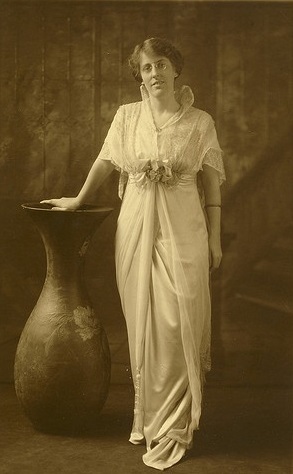 Miss Wilson either joined her mother as hostess at public receptions or presided alone at those where her mother was unable to appear. She also assumed responsibility for entertaining the many members of her extended family and other friends and professional associates of the President who stayed at the White House as houseguests. At times, she was beset with insecurity over her social abilities, feeling “inadequate” as a public figure and often left “so distressingly weary” by the demands for her appearances which she nevertheless felt obligated to meet. She nevertheless recognized her privileged life, characterizing it as “wonderful times” in a “wonderful country,” and that her life as First Daughter was worth “all its horrors.” She was entirely at ease, however, in making public appearances and meeting strangers, her sister characterizing her as being “so vividly intelligent and interested in other people” that she moved without self-consciousness in the public arena. Miss Wilson either joined her mother as hostess at public receptions or presided alone at those where her mother was unable to appear. She also assumed responsibility for entertaining the many members of her extended family and other friends and professional associates of the President who stayed at the White House as houseguests. At times, she was beset with insecurity over her social abilities, feeling “inadequate” as a public figure and often left “so distressingly weary” by the demands for her appearances which she nevertheless felt obligated to meet. She nevertheless recognized her privileged life, characterizing it as “wonderful times” in a “wonderful country,” and that her life as First Daughter was worth “all its horrors.” She was entirely at ease, however, in making public appearances and meeting strangers, her sister characterizing her as being “so vividly intelligent and interested in other people” that she moved without self-consciousness in the public arena.
Bird Sanctuary
During the summer of 1913, in order to provide the First Lady with a chance to focus exclusively on her professional work as a landscape painter, the First Family retreated to the reclusive artist colony in Cornish, New Hampshire, one of the first in the United States.
Illustrator Maxfield Parrish, and sculptors Augustus Saint Gaudens and Daniel Chester French were among the most famous of the painters, etchers, architects, illustrators, decorators, landscape designers, poets, playwrights, novelists, essayists, journalists, composers, actors, singers, and musicians who resided at the Cornish Art Colony.
President and Mrs. Wilson, and their daughters leased the large home of author Winston Churchill known as Harlakenden House, which the press dubbed “The Summer White House.” While the majority of the artists in residence that summer were those working in the fine arts, Margaret Wilson was among those practicing and honing their musical arts skills, including a number of composers.
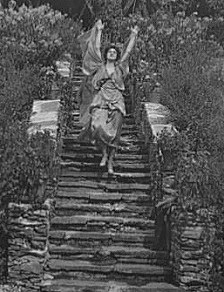 With her commitment to community activities, Margaret Wilson quickly became engaged in fostering public awareness and support for one of the nation’s first sanctuaries for wild birds, located near Cornish. Established three years earlier by the local Meriden Bird Club, the Helen Woodruff Smith Bird Sanctuary created natural habitats for migratory bird. With her commitment to community activities, Margaret Wilson quickly became engaged in fostering public awareness and support for one of the nation’s first sanctuaries for wild birds, located near Cornish. Established three years earlier by the local Meriden Bird Club, the Helen Woodruff Smith Bird Sanctuary created natural habitats for migratory bird.
In August of 1913, shortly after Margaret Wilson expressed interest in supporting the club its manager, the naturalist Ernest Harold Baynes commissioned poet Percy MacKaye to compose a ballad to serve as the script for a performance art piece to be staged one month later, intended to bring public attention to the threatened heron and egret birds.
MacKaye entitled his work Sanctuary: A Bird Masque; it advocated the protection of these large breeds from further hunting for the feathers, which were used in women’s hats and had so diminished their numbers that many feared the breeds’ extinction. MacKaye also staged the production, which also integrated music and dance.
MacKaye drew on Margaret Wilson’s vocal skills as well as her sister Nell’s dancing ability, casting both First Daughters in the production. He called it a “spontaneous and glad cooperation of artists, neighbors, lovers of nature, imbued with a deep feeling in common–concern for the welfare of wild birds.”
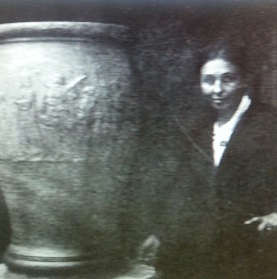 Margaret and Nell Wilson joined the cast in performing Sanctuary on 12 September 1913 in front of a select audience of about sixty. The President and Mrs. Wilson were also in attendance and their presence helped garner national press attention to not only the performance but the civic cause for which it intended to raise public awareness. The issue of bird species protection, through Margaret Wilson’s great interest, found great public support. Whether she sought to directly influence the President on the matter is undocumented but five years later, her father signed the national legislation which enacted the protective Migratory Bird Act. Margaret and Nell Wilson joined the cast in performing Sanctuary on 12 September 1913 in front of a select audience of about sixty. The President and Mrs. Wilson were also in attendance and their presence helped garner national press attention to not only the performance but the civic cause for which it intended to raise public awareness. The issue of bird species protection, through Margaret Wilson’s great interest, found great public support. Whether she sought to directly influence the President on the matter is undocumented but five years later, her father signed the national legislation which enacted the protective Migratory Bird Act.
Margaret Wilson performed as a “spirit voice,” singing from behind shrubbery while her sister Nell, in a bird mask, acted out as a Bird Spirit being pursued by a Hunter. Later, to commemorate the event and raise further more funds the sculptor Marie Saint-Gaudens crafted large Grecian urns with the figures of Margaret Wilson and the other performers carved into a decorative frieze; a limited edition of copies were manufactured and sold to the public to raise further funds for the bird sanctuary.
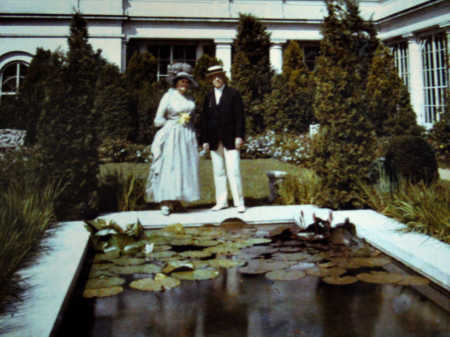 A rehearsal of the performance was chronicled in rare color images by photographer Arnold Genthe, who documented in experimental color autochromes images some of the elaborate thirty costumes worn by performers intended to represent different breeds of birds. Margaret Wilson was especially impressed with this new technology and through her it was later arranged for color autochromes to be made at the White House, with one image depicting the President and his second wife at the East Garden lily pond. A rehearsal of the performance was chronicled in rare color images by photographer Arnold Genthe, who documented in experimental color autochromes images some of the elaborate thirty costumes worn by performers intended to represent different breeds of birds. Margaret Wilson was especially impressed with this new technology and through her it was later arranged for color autochromes to be made at the White House, with one image depicting the President and his second wife at the East Garden lily pond.
Choosing to Remain Unmarried
Margaret Wilson served as maid of honor in the two White House weddings of her younger sisters. She even helped mislead the press, who were attempting to follow her newlywed sister Jessie and her groom and cover their honeymoon, by disguising herself and taking the hand of White House physician Cary Grayson and slipping into a White House limousine as a decoy. For herself, however, Margaret Wilson was decidedly against any possibility of marrying. One biographical account claims that Margaret “was deeply convinced, while in America, that there was none on earth whom a person could love all his life.” Her decision was to provoke public curiosity and judgment.
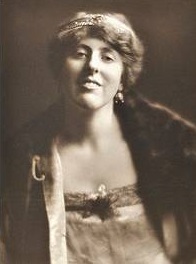 A month after her father’s inauguration, Margaret Wilson had turned 28 years old. Remaining unmarried and pursing a professional singing career with singular intent, she contradicted the general societal expectations that a woman of her age, background and education should forego personal pursuits and seek a traditional life as a wife and mother. A month after her father’s inauguration, Margaret Wilson had turned 28 years old. Remaining unmarried and pursing a professional singing career with singular intent, she contradicted the general societal expectations that a woman of her age, background and education should forego personal pursuits and seek a traditional life as a wife and mother.
This was a pressure applied by newspapers at the time, which was always quick to presume that whenever she was seen in public accompanied by a man that it was a romance or signaled her imminent marriage. For over two years, the press suggested that Margaret Wilson’s marriage to Chicago widower and publisher Frank Compton was imminent until finally a White House denial was issued on 15 October 1915.
She may have once been romantically involved with her friend, Harvard University graduate and writer Boyd Fisher. By his serving as Margaret Wilson’s permanent escort to events in New York, he seemed to the public to be the likeliest candidate for presidential son-in-law. Ellen Wilson certainly liked him, saying he was “quick to take not only an idea but a point of view or an impression.” He seemed to express his frustrated love for her through a play he penned, basing the protagonist on his own feeling that his sweetheart was more committed to her singing career than to him, but declaring that his girlfriend character was “the most beautiful girl in the world.”
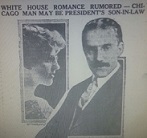 Boyd did all he could to woe Margaret Wilson, even promising to improve his financial prospects as a potential husband. A month before her father was inaugurated, however, a New York Times story reported that although Boyd had the first waltz with Margaret Wilson at a Greenwich Village Valentine’s Day ball, she asserted herself in dancing with many other men through the evening and he clearly could not lay claim to her attention exclusively. Boyd did all he could to woe Margaret Wilson, even promising to improve his financial prospects as a potential husband. A month before her father was inaugurated, however, a New York Times story reported that although Boyd had the first waltz with Margaret Wilson at a Greenwich Village Valentine’s Day ball, she asserted herself in dancing with many other men through the evening and he clearly could not lay claim to her attention exclusively.
Whether it was at the request of Margaret Wilson, the White House Social Secretary felt compelled to issue a denial of such rumors. Ellen Wilson was acutely concerned when newspaper reports and photographs of Sanctuary praised her youngest daughter Nell but gave Margaret Wilson, who had made her own unique costume “no compliments.”
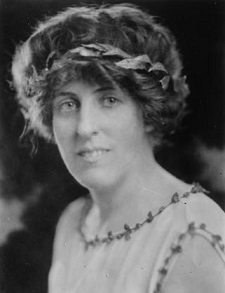 The issue of Margaret Wilson’s perpetual status as a single woman finally led to the historically unprecedented act of a U.S. President delivering a public rebuke of the press on a personal matter, the first documented instance of a First Daughter being the subject matter: The issue of Margaret Wilson’s perpetual status as a single woman finally led to the historically unprecedented act of a U.S. President delivering a public rebuke of the press on a personal matter, the first documented instance of a First Daughter being the subject matter:
“I am a public character for the time being, but the ladies of my household are not servants of the government and they are not public characters,” President Wilson told the White House press corps. “I deeply resent the treatment they are receiving at the hands of the newspapers at this time. Take the case of my oldest daughter. It is a violation of my own impulses to speak of these things, but my oldest daughter is constantly represented as being engaged to this, that or the other man in different parts of the country; in some instances, to men she has never even met in her life. It is a constant and intolerable annoyance. These things are printed without any attempt to verify them by communications with the White House and, when explicit denials are received from persons who are known to tell the truth, and to feel bound to tell the truth, those denials are not respected in the least. On the contrary, they are represented as avoidances. If this continues I shall deal with you, not as President, but as man to man.”
White House Music Director
From the start of the first Wilson Administration term, until April of 1916 when her father entered the U.S. into World War I, Margaret Wilson organized the musical entertainments hosted in the White House during the tenures of both her mother and stepmother and the interim period when she was acting as First Lady. Several were notable for the international character of the music. On February 28, 1914, Margaret Wilson arranged for a unique White House performance of a Russian Orthodox Church musical concert, a program of thirty-five member male choir of New York St. Nicholas Cathedral conducted by Moscow’s Holy Synod Choir director I.T. Gorokhoff.
Another uniquely international White House concert was one conducted by Spain’s Enrique Granados on March 7, 1916. Beloved in his own country, the respected composer performed, among other works, his own composition “Danza Valenciana,” and excerpts from his opera Goyascas, which represented his interpretation of Spain’s famous painter Goya. A third such event with foreign flavor was the March 28, 1916 concert by celebrated Australian composer and pianist Percy Grainger who performed a number of his own original works which captured aspects of Australian life and culture. Louise Llewellyn, although of Welsh background, also performed a series of Hungarian songs while dressed in traditional Hungarian folk costume.
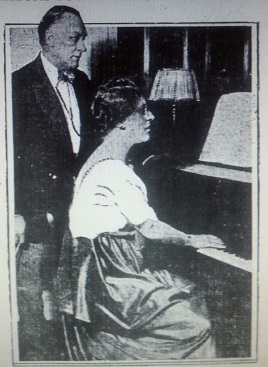 Apart from arranging for his performance at the White House, Margaret Wilson also assumed personal responsibility for the needs of Ignatz Paderewski, the most prominent musician to perform at the Wilson White House following a state dinner. Doting on him before his concert, she fetched him a bowl of warm water to soothe his stiff, cold hands. During the performance as a drunken Senator began to interrupt the legendary pianist, the First Daughter saw to it that he was immediately ejected. Apart from arranging for his performance at the White House, Margaret Wilson also assumed personal responsibility for the needs of Ignatz Paderewski, the most prominent musician to perform at the Wilson White House following a state dinner. Doting on him before his concert, she fetched him a bowl of warm water to soothe his stiff, cold hands. During the performance as a drunken Senator began to interrupt the legendary pianist, the First Daughter saw to it that he was immediately ejected.
Numerous First Ladies who were musically skilled in playing musical instruments or singing had performed for private guests and family members in the private quarters of the White House at intimate gatherings, but Margaret Wilson was the only one known to have appeared at public White House entertainments, joining in at least three known formal musicales hosted both before and after her mother’s death, including a May 27, 1914 recital, accompanying harpist Melville Clark. Among the distinguished singers she arranged to have perform at the White House were Alice Nielsen, Vernon Stiles, Mary Jordan, Ernestine Schumann-Heink and Louis Graveure.
Political Issues and Social Welfare
Margaret Wilson worked with her mother on various public welfare issues in Washington, D.C. and at least one area of interest which has been previously associated with Ellen Wilson was likely an endeavor initiated by the First Daughter. On two significant social and political issues, Margaret Wilson’s views conflicted with those of her parents.
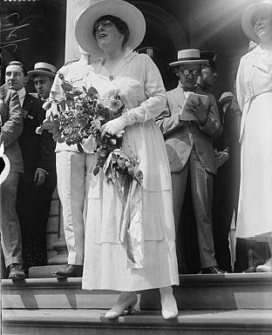 Like both of her sisters, Margaret Wilson was an overt supporter of women’s suffrage. She remained acutely aware of sexism and found it personally frustrating; her sister recalled that she “often lamented the fact that she was a girl.” In 1920, the last year of her father’s presidency, when passage of the 18th Amendment granted women the right to vote, Margaret Wilson did not join the Democratic Party of her father, but rather the National Women’s Party. A year later she addressed the party’s national convention. Like both of her sisters, Margaret Wilson was an overt supporter of women’s suffrage. She remained acutely aware of sexism and found it personally frustrating; her sister recalled that she “often lamented the fact that she was a girl.” In 1920, the last year of her father’s presidency, when passage of the 18th Amendment granted women the right to vote, Margaret Wilson did not join the Democratic Party of her father, but rather the National Women’s Party. A year later she addressed the party’s national convention.
While she never publicly criticized President Wilson’s approval of racial segregation in the federal workplace, she did undertake at least one project intended to ensure that the African-American communities had equal access to forums on public welfare issues in both in Washington and New York. Margaret Wilson’s unique advocacy that public school auditoriums be opened to all citizens for use as “town hall” forum meetings on issues facing all communities and as polling places led to her becoming the only First Daughter in presidential history to ever testify before a Congressional committee hearing.
As early as June of 1914, Margaret Wilson was making news as an advocate for the new Community Centre Organization which sought to establish the use of large, publicly-funded meeting places. In Washington, the First Daughter saw an especially great need for gathering into one forum a place for residents to voice their concerns and opinions, in conjunction with the First Lady’s effort to replace the sub-standard housing largely occupied by poorer and working-class African-American families. As a 19 April 1916 news story reported, the “common folks are disposed to take off their hats” for “the way she has been making the people's fight.”
In 1915, after discovering that the U.S. Congress, which regulated the district of Columbia’s school system, forbade its buildings from being used for any purpose other than classes, Margaret Wilson successfully lobbied Kentucky Congressman Ben Johnson, chairman of the House District Committee and had this edict overturned. The new ruling, however, made the use of schools conditional on the consent of the local school board. In the spring of 1916, when the school board refused permission for use of its Grover Cleveland School by the neighborhood alliance, reporter Gilson Gardener declared that, “This started Miss Wilson on the warpath again. She didn't want permission she wanted the right of the people of Washington to use their schools when and how they pleased.”
In a series of Sunday meetings at a local public library, Margaret Wilson rallied other local neighborhood alliances and forums to join together as a strong and unified force in support of her effort. She personally lobbied members of Congress to support the measure, resulting in speeches made on the House floor by Representative Robert Crosser and other liberal member of Congress backing her case and Chairman Johnson introducing a new bill granting citizens the right to use the schools as meeting places outside of classroom hours.
In April of 1916, Margaret Wilson became the only First Daughter to deliver congressional testimony, appearing before a District Committee hearing to make her case. Despite the shock of being “unpleasantly heckled” by Congressmen James Ragsdale of South Carolina and Benjamin Focht of Pennsylvania, she “held up her end of the scrap,” and proved successful in forcing the legislation through to passage.
Unspoken but understood in the argument was the fact that the new ruling would permit African-American citizen forums the right to gather and meet in the racially-segregated city’s whites-only schools. Despite her fierce advocacy, Margaret Wilson resisted from raising the racist motives behind the challenge to her intentions. During a meeting of the League for Political Education in New York’s Hudson Theater she joined the Commissioner of Correction, and the Chairman of the Industrial Relations Commission in support of using municipal buildings as “public opinion social centers.” When an audience member suggested to the First Daughter that opening these forums without regard to race or class would invite “the rabble” among upright citizens, Margaret Wilson shot back sharply, “What do you mean by the ‘rabble’?”
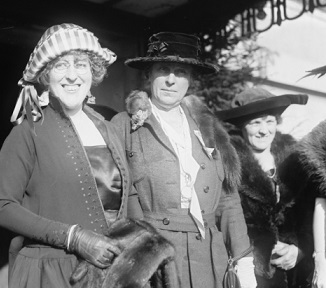 Along with her advocacy for adult “town halls,” Margaret Wilson also undertook the promotion of adapting more school playing fields and public parks for use as recreational centers for children. “She says we should give kids the good times the grown-ups have had in the past,” declared one newspaper headline reporting on her addressing the issue in her speech before a biennial convention of the General Federation of Women. Along with her advocacy for adult “town halls,” Margaret Wilson also undertook the promotion of adapting more school playing fields and public parks for use as recreational centers for children. “She says we should give kids the good times the grown-ups have had in the past,” declared one newspaper headline reporting on her addressing the issue in her speech before a biennial convention of the General Federation of Women.
Death of Her Mother
Especially sensitive to her mother’s well-being, Margaret Wilson grew especially alarmed as she detected a growing bodily weakness in Ellen Wilson. The president’s wife sought to dissuade her concern, declaring that with such a devoted daughter, “how can I fail of coming back to life?” Margaret’s Margaret Wilson was praying at the foot of her mother’s bed at the time of her death in the White House. Since his other daughters were now married, the President turned to Margaret for the feminine emotional support which always sustained him, writing in one letter that she was “the most loving and lovable.”
Musical Career
Throughout the spring of 1913, Margaret Wilson continued her voice lessons, commuting to New York where she studied with teacher Ross David. Rather than let her training lapse during the First Family’s summer sojourn in Cornish, New Hampshire, she coaxed David to relocate for the month of August there so they might continue his work with her.
Although she was still seeking to improve her voice, Margaret Wilson’s fame as First Daughter led to numerous opportunities to perform publicly. She appeared at several recitals in New York, and headlined a concert held in Philadelphia’s Bellevue-Stratford Hotel to fundraise for that city’s Kensington Home, a shelter and social center for the city’s young, unmarried women who worked in the regional milling factories. Her sister Jessie Wilson had been a long-time volunteer at the shelter.
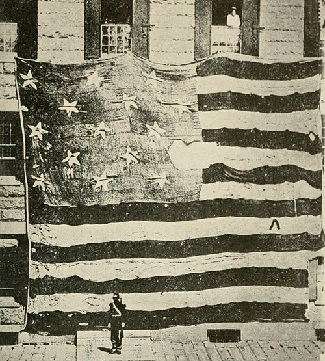 Early in 1915, while now acting as First Lady, Ross David arranged for Margaret Wilson to perform her first public recital, a limited venue at Baltimore’s Bandbox Theatre before a supportive audience composed largely of her friends and relatives. Although other voice students studying with David also performed, Margaret Wilson was allotted nearly half of the recital time. Accompanied by a violinist and harpist, she sang three sets of songs, including a group of by three German composers, “Le Nil” by Leroux and Schubert’s “Ave Maria.” One critic found her rendition of “Ave Maria” to be "an act of worship" Early in 1915, while now acting as First Lady, Ross David arranged for Margaret Wilson to perform her first public recital, a limited venue at Baltimore’s Bandbox Theatre before a supportive audience composed largely of her friends and relatives. Although other voice students studying with David also performed, Margaret Wilson was allotted nearly half of the recital time. Accompanied by a violinist and harpist, she sang three sets of songs, including a group of by three German composers, “Le Nil” by Leroux and Schubert’s “Ave Maria.” One critic found her rendition of “Ave Maria” to be "an act of worship"
Later that year, Margaret Wilson undertook a full public concert tour, debuting with the Chicago Symphony Orchestra in Syracuse. While she sought to be judged on her professional merits, it was nearly impossible for critics to ignore the unprecedented fact that the performer was the First Lady. One newspaper offered the flattery that her soprano voice would “command recognition quite independent of her distinguished parent,” while another made the gentle observation that, “there are many voices that appear bigger, but hers is so clear, so pure, that it carries….” Despite her status as First Lady, however, her performance was not falsely praised. One critic offered a mixed review, stating that her voice’s “sympathetic quality is its most commendable attribute. She sings with intelligence and feeling and without affectation. A slight tremolo in the high notes and a husky quality most noticeable in the upper and lower registers, were her most serious faults.”
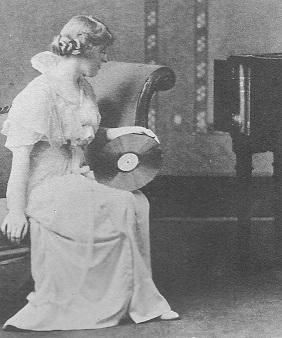 In May of 1915, while continuing her public concert tour, Margaret Wilson performed at the Panama Pacific International Exposition in San Francisco. While there, she sang her rendition of all stanzas of the Star Spangled Banner and agreed to have it recorded as an album to be sold publicly. Her royalties from it would be donated to the American Red Cross International Board of Relief, to purchase medical and food supplies for the increasing number of Belgium and French people being displaced as refugees in the European “Great War” that had been raging since August of 1914. The album carried a message from Margaret Wilson stating that, “This Record of my voice if sold by the Columbian Gramophone Company shall yield to the American Red Cross the sum of 25 cents covering my entire royalty.” In May of 1915, while continuing her public concert tour, Margaret Wilson performed at the Panama Pacific International Exposition in San Francisco. While there, she sang her rendition of all stanzas of the Star Spangled Banner and agreed to have it recorded as an album to be sold publicly. Her royalties from it would be donated to the American Red Cross International Board of Relief, to purchase medical and food supplies for the increasing number of Belgium and French people being displaced as refugees in the European “Great War” that had been raging since August of 1914. The album carried a message from Margaret Wilson stating that, “This Record of my voice if sold by the Columbian Gramophone Company shall yield to the American Red Cross the sum of 25 cents covering my entire royalty.”
Newspaper advertisements for the album made a patriotic appeal to potential buyers: “The first lady of the land has made a recording of the first song of the land—The Star-Spangled Banner. It is a record that will not only carry a duel appeal to American patriotism and American generosity, but will also bring a full share of enjoyment with it because Miss Wilson has recorded this martial air with all the fervor with which it should be rendered.”
Role in the President’s Remarriage
Margaret Wilson also played a pivotal role in her father’s courtship of and eventual marriage to the widow Edith Bolling Galt. As early as May of 1914, the president’s daughter met Altrude Gordon, the girlfriend of the president’s doctor, who proved to be the link between the Wilsons and her friend Edith Galt.
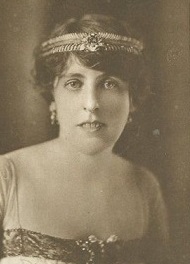 Although Helen Bones had been the initial First Family member who first had contact with the woman soon to become the second Mrs. Woodrow Wilson, within a month Margaret Wilson wanted to meet this woman who had suddenly become important to her father. By the end of April 1915, Margaret Wilson often arrived in a limousine to the nearby home of Mrs. Galt to retrieve her and then return to the White House where the President and his doctor joined them for a long evening drive and then dinner in the executive mansion. Although Helen Bones had been the initial First Family member who first had contact with the woman soon to become the second Mrs. Woodrow Wilson, within a month Margaret Wilson wanted to meet this woman who had suddenly become important to her father. By the end of April 1915, Margaret Wilson often arrived in a limousine to the nearby home of Mrs. Galt to retrieve her and then return to the White House where the President and his doctor joined them for a long evening drive and then dinner in the executive mansion.
Months later, Mrs. Galt was invited by the President to join the family at their summer vacation home in Cornish, New Hampshire but she made the trip escorted by Margaret Wilson and the press and public were explicitly told that she was a friend and guest of the First Daughter. In order to avoid a backlash of resentment by the public which had been sympathetic following Ellen Wilson’s death, President Wilson himself sought to exploit his daughter in composing his own press release, in which he falsely claimed:
“It was Miss Margaret Wilson and her cousin Miss Bones who drew Mrs. Galt into the White House circle. They met her first in the early part of the present year and were so much attracted to her that they sought her out more and more frequently and the friendship among them quickly ripened into an affection intimacy. It was through this association with his daughter and cousin that the President had the opportunity to meet Mrs. Galt, who spent a month at Cornish this summer as Wilson’s guest.”
The President went further in his initial effort to use Margaret Wilson and her sisters, suggesting they practically implored him to remarry only sixteen months after the death of their beloved mother: “It is, indeed, the most interesting of circumstances connected with the engagement just announced that the President’s daughters should have picked Mrs. Galt out for their special admiration and friendship before their father did.” Recognizing this assertion as patently false, President Wilson decided to excise the statement from his final press release. Once it was a foregone conclusion that the President would marry Mrs. Galt in December of 1915, Margaret Wilson wrote her a warm letter of welcome into the family.
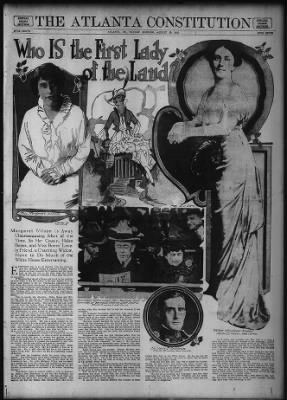 Margaret Wilson was with her father and stepmother at Shadow Lawn, the private New Jersey estate which the family leased during the summer and fall of the 1916 presidential campaign on Election Night. As they waited for early returns from all the national polling places, she received a phone call tipping her off that the New York Times was so confident that her father had lost his re-election bid that it would be announcing the news in its early edition. Devastated by this, Margaret Wilson shared the news with the President and his wife. The interchange which ensued illustrated the shift which had taken place in terms of which of the two women, his wife or his daughter, now held the greatest control over the President. Rather than being upset by the seeming prediction of election loss, Edith Wilson was pleased because it would now mean she could have Woodrow Wilson’s time and attention to herself as a new husband. Both Edith Wilson and Margaret Wilson remained awake through the night as returns continued to come in. At four in the morning, Margaret Wilson received a call from campaign headquarters that her father had won the popular vote in Ohio and many western states. She went to report this good news to her father – but Edith Wilson forbid Margaret Wilson from having her usual access to the President, insisting that he be permitted to sleep until morning. Margaret Wilson was with her father and stepmother at Shadow Lawn, the private New Jersey estate which the family leased during the summer and fall of the 1916 presidential campaign on Election Night. As they waited for early returns from all the national polling places, she received a phone call tipping her off that the New York Times was so confident that her father had lost his re-election bid that it would be announcing the news in its early edition. Devastated by this, Margaret Wilson shared the news with the President and his wife. The interchange which ensued illustrated the shift which had taken place in terms of which of the two women, his wife or his daughter, now held the greatest control over the President. Rather than being upset by the seeming prediction of election loss, Edith Wilson was pleased because it would now mean she could have Woodrow Wilson’s time and attention to herself as a new husband. Both Edith Wilson and Margaret Wilson remained awake through the night as returns continued to come in. At four in the morning, Margaret Wilson received a call from campaign headquarters that her father had won the popular vote in Ohio and many western states. She went to report this good news to her father – but Edith Wilson forbid Margaret Wilson from having her usual access to the President, insisting that he be permitted to sleep until morning.
Margaret Wilson seemed to defer to her stepmother, however, without resentments. When Edith Wilson suddenly decided she wished to learn how to ride a horse, for example, Margaret Wilson thoughtfully loaned her a pair of her own riding breeches.
World War I
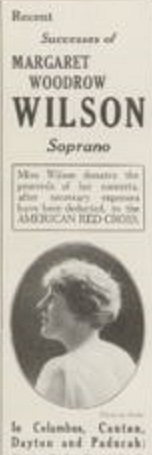
Margaret Wilson sat with Edith Wilson in the most prominent seats of the visitor’s gallery of the U.S. Capitol Building’s Senate Chamber to hear President Wilson deliver his declaration of war message in April of 1917, commencing the U.S. involvement in the European conflict.
During the initial period following U.S. entry into World War I, Margaret Wilson worked as a Red Cross volunteer at the canteen established at Washington’s Union Station, helping to distribute items and serve food and beverages to incoming trainloads of servicemen, on their way from training camps to ship transports taking them to the war front. There she worked alongside a young Eleanor Roosevelt, then the wife of the Assistant Navy Secretary, Florence Harding, then the wife of a U.S. Senator, and Alice Roosevelt Longworth, the daughter of former President Theodore Roosevelt and wife of a Congressman.
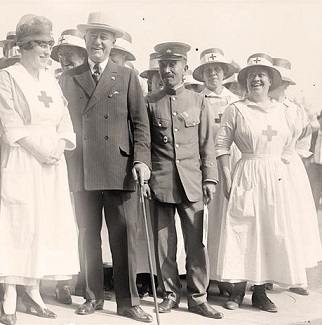 World War I gave Margaret Wilson a sense of urgent purpose. Inspired by the success of her Star Spangled Banner record album sales, she began a grueling national tour through 1917 and 1918, providing free concert performances to enlisted servicemen at U.S. military training camps and ticketed open-air public concerts to raise funds for the Red Cross and other charitable organizations underwriting war relief efforts. The public response was tremendous. After a Denver concert sold out with 12,000 ticket-buyers in attendance, she provided a free concert the following evening for 13,000 listeners. One YMCA National War Committee reporter recorded the poignancy of one such performance at a training camp where some ten thousand servicemen had just learned they had been scheduled to ship out to the European war front. In reaction to her medley of sentimental popular American music, thousands of the young men began to cry with, “the knowledge that there would be no furloughs home before the big movement began.” World War I gave Margaret Wilson a sense of urgent purpose. Inspired by the success of her Star Spangled Banner record album sales, she began a grueling national tour through 1917 and 1918, providing free concert performances to enlisted servicemen at U.S. military training camps and ticketed open-air public concerts to raise funds for the Red Cross and other charitable organizations underwriting war relief efforts. The public response was tremendous. After a Denver concert sold out with 12,000 ticket-buyers in attendance, she provided a free concert the following evening for 13,000 listeners. One YMCA National War Committee reporter recorded the poignancy of one such performance at a training camp where some ten thousand servicemen had just learned they had been scheduled to ship out to the European war front. In reaction to her medley of sentimental popular American music, thousands of the young men began to cry with, “the knowledge that there would be no furloughs home before the big movement began.”
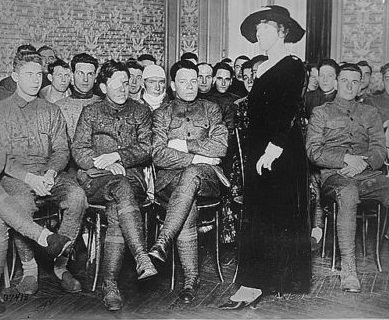 Developing an affinity with the young serviceman, Margaret Wilson determined to further do what she could to alleviate their anxieties at the warfront. Despite the President forbidding her from undertaking such an extended and dangerous mission, she defied him and journeyed in a navy transport in early 1918 to the war zones of France. “Margaret had her own ideas,” her sister Nell Wilson recalled, “and rarely asked for advice.” Developing an affinity with the young serviceman, Margaret Wilson determined to further do what she could to alleviate their anxieties at the warfront. Despite the President forbidding her from undertaking such an extended and dangerous mission, she defied him and journeyed in a navy transport in early 1918 to the war zones of France. “Margaret had her own ideas,” her sister Nell Wilson recalled, “and rarely asked for advice.”
The President’s daughter often journeyed down muddy roads that had been blasted by enemy artillery and risked gunfire to perform for American troops at base camps. She also ventured into hospitals and medic units in the field to comfort servicemen wounded in battle and witnessed some of the gruesome realities among the injured and dying. She continued this for nearly a year, until the Armistice ending the war was signed.
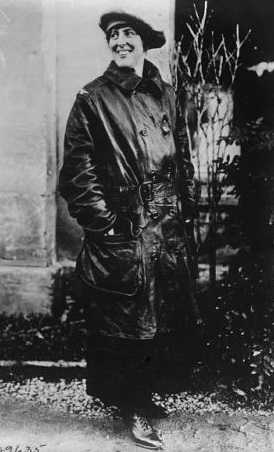 When Wilson broke precedent to become the first incumbent President to make an overseas trip to attend the Paris Peace Conference after World War I, Margaret Wilson was waiting at the dock at Brest, France at 13 December 1918 to welcome him and the First Lady. When Wilson broke precedent to become the first incumbent President to make an overseas trip to attend the Paris Peace Conference after World War I, Margaret Wilson was waiting at the dock at Brest, France at 13 December 1918 to welcome him and the First Lady.
She joined them as they proceeded to Paris in the French president’s personal railroad car and resided in the regal Murat Palace. She was part of a touring party through war-torn Belgium, along with Herbert Hoover who led humanitarian efforts to prevent massive death by starvation in that nation.
Margaret Wilson was treated with a lower status when the presidential party was the guests of the King and Queen of Belgium; during their parade through Brussels, the First Daughter was demoted to a mere rumble seat rather than given a prominent spot in one of the open-car vehicles.
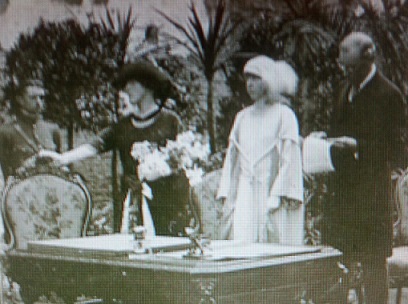 The president’s daughter was only one of five American women who were permitted to witness the signing of the Versailles Treaty, which negotiated the terms of the war’s end and where her father’s vision of a League of Nations was first publicly advanced. The president’s daughter was only one of five American women who were permitted to witness the signing of the Versailles Treaty, which negotiated the terms of the war’s end and where her father’s vision of a League of Nations was first publicly advanced.
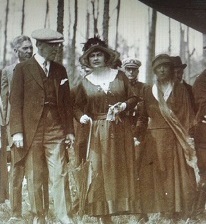 Making the return trans-Atlantic voyage with him, she proudly pointed out that the vast crowds which welcomed them in New York were “all for you,” and there was “never such a triumph.” More cynically, he retorted, “Wait until they turn.” Making the return trans-Atlantic voyage with him, she proudly pointed out that the vast crowds which welcomed them in New York were “all for you,” and there was “never such a triumph.” More cynically, he retorted, “Wait until they turn.”
Traumatized by the gory realities of war and having stressed her physical strength by complying with any request to perform for servicemen, Margaret Wilson returned to the U.S. in such broken health that she was required to take complete physical rest for two months at the Grove Oak Inn in North Carolina. During her stay there, she encountered U.S. Army general John J. Pershing and members of his senior staff on leave.
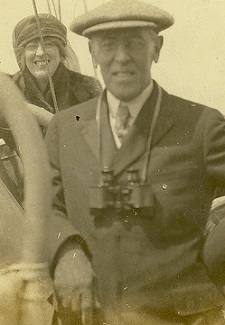 Recalling her war service but never having personally heard her perform at the front, Pershing asked if she would sing for them. When she revealed to him that her singing voice had been destroyed “beyond repair” because of the strain she had caused it, he rose to deliver a toast in her honor: “To Miss Wilson, just as much a victim of war service as were the soldiers who filled this country’s hospitals.” Recalling her war service but never having personally heard her perform at the front, Pershing asked if she would sing for them. When she revealed to him that her singing voice had been destroyed “beyond repair” because of the strain she had caused it, he rose to deliver a toast in her honor: “To Miss Wilson, just as much a victim of war service as were the soldiers who filled this country’s hospitals.”
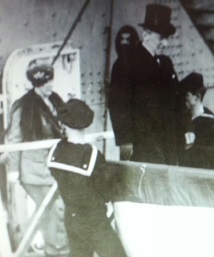 The President’s Stroke and Disability The President’s Stroke and Disability
With her musical career abruptly ended, Margaret Wilson returned to live primarily in the White House, although still maintaining her apartment in New York City. When President Wilson suffered a debilitating nervous breakdown in the fall of 1919 while touring the country to promote the League of Nations and was rushed back to Washington, D.C. it was Margaret Wilson and not his wife Edith Wilson, who initiated the first effort to affect a public image that was at odds with the true nature of his condition. Waiting for him at Washington’s Union Station, she had him lean on her arm and then escorted the President through the concourse past the eyes of the news reporters and photographers and curious public onlookers and out to his waiting limousine, whisking them to the White House.
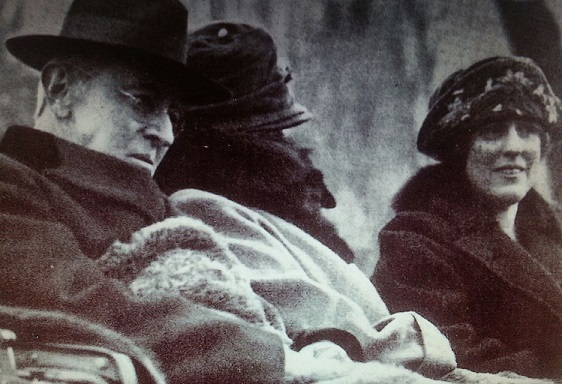
During the first days after he suffered a debilitating stroke in the White House, the consulting physicians verbally reported the facts of his paralysis and unlikely recovery from it to not just the First Lady but Margaret Wilson. She took turns with a professional nurse and her stepmother in remaining at his bedside. In February of 1920, only Margaret Wilson and her stepmother were informed by doctors of the dangerous severity of influenza befalling the President, but this was withheld from the public. Like all members of the president’s inner circle Margaret Wilson acquiesced entirely to the wishes of Edith Wilson to suppress public knowledge of just how gravely disabled the President’s stroke had left him.
It is unclear whether Margaret Wilson acted on her own accord or at the behest of the President or First Lady when she made a stealth visit to the now-estranged Colonel Edmund House, once the President’s closest adviser in December of 1919. During the League fight in the Senate, House had written three letters to the President suggesting he not accept a compromise on his vision of the League and offered vacillating strategies to assure partial passage. Edith Wilson, however, refused to have the letter shown to the President. Attempting to negotiate a repair of the friendship, Margaret Wilson suggested that House’s unsolicited advice had offended her father but he assured her that his only motivation was to see that some form of the League passed not only because it would serve as a foundation for his global legacy but also spare him further stress. Acting as a liaison between the two men, Margaret Wilson carried this message directly to her father’s bedside but Wilson repeated Edith Wilson’s initial assessment of House as being too weak and that any effort for the old friends to again meet would prove “embarrassing for them both.”
Life after the White House:
When the Wilson presidency ended in March of 1921, Margaret Wilson resumed full-time residency in New York City and spent weekends in Washington with her father and stepmother.
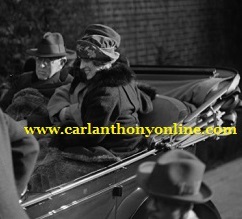 Despite her occasional intellectual challenges to him, Margaret Wilson believed her father possessed a wisdom that “approached seership.” During their weekend visits in his three post-presidential years, he assessed his presidency with more frankness to her than with any other known person. Although she disagreed, Wilson shocked her by saying it was ultimately a good thing that the League of Nations had not passed at the time of his presidency for then it would have merely been viewed as a measure of his personal success. He continued that, “Now, when the American people join the League it will be because they are convinced it is the only right time for them to do it.” This revelation to Margaret Wilson is the only documented account which suggests that Wilson did come to acknowledge that his personalizing the League of Nations debate may have led to its defeat. Despite her occasional intellectual challenges to him, Margaret Wilson believed her father possessed a wisdom that “approached seership.” During their weekend visits in his three post-presidential years, he assessed his presidency with more frankness to her than with any other known person. Although she disagreed, Wilson shocked her by saying it was ultimately a good thing that the League of Nations had not passed at the time of his presidency for then it would have merely been viewed as a measure of his personal success. He continued that, “Now, when the American people join the League it will be because they are convinced it is the only right time for them to do it.” This revelation to Margaret Wilson is the only documented account which suggests that Wilson did come to acknowledge that his personalizing the League of Nations debate may have led to its defeat.
She and Edith Wilson were each holding a hand of his when he died on 3 February 1924. Within hours, however, a breach between the two women took place. Margaret Wilson began to speak rapidly but calmly about the Christian Science belief that death was “an allusion,” and Edith Wilson responded by verbally belittling her, despite the best efforts of Dr. Grayson to cool the widow down by explaining that her late husband’s daughter was in a state of shock. Edith Wilson further lashed out at Margaret’s sister Nell and caused a permanent estrangement with her. Jessie Sayre, the third Wilson daughter, was in Siam where her husband was on a diplomatic mission but she too withdrew from contact with Mrs. Wilson in reaction to the treatment her sisters received.
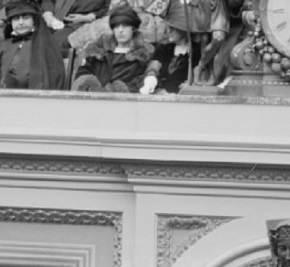 There was another reason for the strain which developed between Margaret Wilson and Edith Wilson, who considered herself the sole director of his public legacy. The late President Wilson’s will stipulated that, if she remained unmarried, Margaret Wilson would receive a $2,500 annuity on the condition that this amount didn’t exceed one-third of his estate’s annual income. Although she lived modestly, the amount was not enough to adequately support the former First Lady and she began to seek some form of employment. There was another reason for the strain which developed between Margaret Wilson and Edith Wilson, who considered herself the sole director of his public legacy. The late President Wilson’s will stipulated that, if she remained unmarried, Margaret Wilson would receive a $2,500 annuity on the condition that this amount didn’t exceed one-third of his estate’s annual income. Although she lived modestly, the amount was not enough to adequately support the former First Lady and she began to seek some form of employment.
One source claimed vaguely that she briefly worked as a sales clerk in New York. It is certain that Margaret Wilson did find her steadiest source of income on a consulting basis of employment, working as a copywriter for the Biow Agency, a New York advertising firm. This did not prove reliable enough, however, and she involved herself in some type investment brokerage deal in which she solicited friends and family to purchase stock in an oil company. It proved to be a losing venture and Margaret Wilson then made the effort to repay all those who had placed their faith in her, although it is not apparent that she was legally culpable.
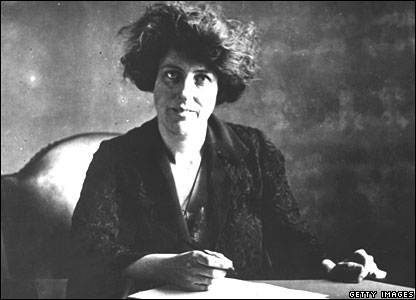 When Margaret Wilson’s personal financial situation became dire, she permitted her father’s former press secretary Joe Tumulty to make discreet legal inquiries about any potential flexibility in Wilson’s will. In short order, Edith Wilson was informed of this by her attorney and feared that her stepdaughter was mounting a challenge to the late President’s will. Although she had been granted a federal presidential widow’s pension and the franking privilege, and inherited the bulk of his estate and the Washington mansion which she and the former President had shared, Edith Wilson made no offers of financial help to Margaret Wilson and limited contact with her save for the most perfunctory of matters. When Margaret Wilson’s personal financial situation became dire, she permitted her father’s former press secretary Joe Tumulty to make discreet legal inquiries about any potential flexibility in Wilson’s will. In short order, Edith Wilson was informed of this by her attorney and feared that her stepdaughter was mounting a challenge to the late President’s will. Although she had been granted a federal presidential widow’s pension and the franking privilege, and inherited the bulk of his estate and the Washington mansion which she and the former President had shared, Edith Wilson made no offers of financial help to Margaret Wilson and limited contact with her save for the most perfunctory of matters.
The trust for goodness which Margaret Wilson sometimes misplaced in others became a matter of public record in March of 1926. After two teenagers were arrested after breaking into her apartment in an attempted robbery, the former First Daughter was called into court to deliver her eyewitness account, but she refused to press charges against them. The judge scolded her for preventing prosecution and thus denying them a chance to learn a lesson in responsibility; Margaret Wilson smilingly retorted, “The best lesson for them is the lesson of kindness.” There soon followed a New York Times editorial which judged her to be “more kind than wise.”
Relocation to India
Searching for a deeper sense of meaning to her life with many unanswerable questions about existence troubling her, Margaret Wilson began to find a measure of calm by beginning to practice yoga, introduced to her in 1924 by a British Army officer friend, who had learned it in India. In conjunction with her new interest in Hindu and Buddhist tenets, Margaret Wilson had also become “intensely interested in India,” as a colleague of hers recalled. Margaret Wilson had long refused to participate in some traditional Christian rituals, like the taking of communion but rejected no particular faith strenuously. Always a reader of philosophy, by 1929 she stated that her mission was for “the realization of God Consciousness.”
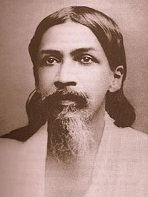 In 1936, while continuing to do her research, she discovered a copy of Essays on the Gita, written by Aurobindo Ghose (known as “Sri Aurobindo”) in the stacks of the New York Public Library and became so engrossed in what she discovered that she had to be told by a guard that the building was closing. She returned the following day and completed reading the book. It prompted her to write the author, a mystic and spiritual leader of an ashram, a community of followers, on the southeastern coast of India. Sri Aurobindo, born in 1872 and educated at Cambridge University in England, established the ashram in 1910, but largely remained in meditative seclusion. It was practically managed by Mirra Alfassa (born in France, in 1878). In 1936, while continuing to do her research, she discovered a copy of Essays on the Gita, written by Aurobindo Ghose (known as “Sri Aurobindo”) in the stacks of the New York Public Library and became so engrossed in what she discovered that she had to be told by a guard that the building was closing. She returned the following day and completed reading the book. It prompted her to write the author, a mystic and spiritual leader of an ashram, a community of followers, on the southeastern coast of India. Sri Aurobindo, born in 1872 and educated at Cambridge University in England, established the ashram in 1910, but largely remained in meditative seclusion. It was practically managed by Mirra Alfassa (born in France, in 1878).
Margaret Wilson was soon writing Aurobindo for permission to relocate there to become one of his disciples and have a “living spiritual experience.” Sri Aurobindo responded that “it can only be fulfilled by an outflowing of the inner realization, something that grows from within outward, not by the working out of a mental principle…” He further advised her to “practice of concentration of your consciousness within yourself,” beneath the “ordinary human mind…activity on the surface,” to be “silent, calm, unbound and unattached…”
While the Sri offered to respond to any questions she might further have, as Margaret Wilson began to discipline herself along these instructions, she determined to relocate to the ashram in India, despite her increasingly precarious health. The Sri responded that, “The sudden change of climate and ways of life may be hard to bear. Moreover there will not be truly competent medical aid and advice available here as it would be in America.”
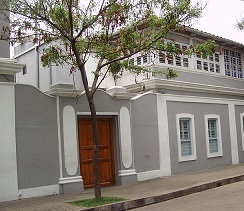 Finally, ignoring her worsening condition of arthritis, Margaret Wilson left the United States forever in October of 1938 and settled in Pondicherry, India as part of the community of followers of Sri Aurobindo. An article by Anurag Banerjee details Margaret Wilson’s fulfilling life there, recalling that the Sri was so impressed by her single-mindedness, he gave her the name of “Nishtha,” because of her “one-pointed, fixed and steady concentration, devotion and faith in the single aim.” It is the Sanskrit word for "sincerity." A month after arriving, with others in the spiritual community, Margaret Wilson was eager to receive the blessing of Sri Aurobindo on “Darshan Day,” scheduled only three times a year. A sudden fall and bone fracture prevented him from appearing but he was struck by her calm acceptance rather than disappointment to this news. “She has taken it with the right attitude—unlike many,” he noted. Finally, ignoring her worsening condition of arthritis, Margaret Wilson left the United States forever in October of 1938 and settled in Pondicherry, India as part of the community of followers of Sri Aurobindo. An article by Anurag Banerjee details Margaret Wilson’s fulfilling life there, recalling that the Sri was so impressed by her single-mindedness, he gave her the name of “Nishtha,” because of her “one-pointed, fixed and steady concentration, devotion and faith in the single aim.” It is the Sanskrit word for "sincerity." A month after arriving, with others in the spiritual community, Margaret Wilson was eager to receive the blessing of Sri Aurobindo on “Darshan Day,” scheduled only three times a year. A sudden fall and bone fracture prevented him from appearing but he was struck by her calm acceptance rather than disappointment to this news. “She has taken it with the right attitude—unlike many,” he noted.
Some later chroniclers mistakenly attempted to depict Margaret Wilson as having been drawn into some type of cult. In fact, she was explicitly told by the “Mother” of the ashram that in living as part of the ashram there were no financial commitments, promises to physically remain there or religious pledges necessary. From the monthly check she continued to receive from her father’s estate, she donated a monthly amount of one hundred dollars to the ashram.
Nor did Margaret Wilson perceive herself as having relocated to some holy land, writing a friend that “I am beginning to see that all the bondage here as elsewhere and everywhere are our own making.” She lived in a large, airy modern apartment with a view of the sea and maintained a tropical garden. She continued to smoke cigarettes, wear western clothing and subscribed to American newspapers and magazines. Her sister Nell regularly sent Margaret Wilson her favorite facial creams.” The ashram provided her with a cook and a maid. She also continued to celebrate Christmas Day, joining with others living in the ashram from different countries during her first year there to mark the Christian holiday, and made and placed a large star atop a Christmas tree. On her Corona typewriter, she wrote frequent letters to her sister Nell McAdoo and friends in the U.S. In at least one other later Christmas during her residency there, she crafted another star, likely a custom she developed within the community’s annual celebration.
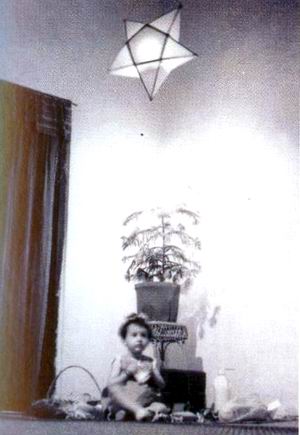 Margaret Wilson was also moved by the culture of India, enthralled with the undulating walk which many of its women went about their day, the colors of sari dresses, the music and its historically-preserved temples. Learning to appreciate the lifestyle, she came to believe that “America must discover India’s secrets before she can discover herself.” Margaret Wilson was also moved by the culture of India, enthralled with the undulating walk which many of its women went about their day, the colors of sari dresses, the music and its historically-preserved temples. Learning to appreciate the lifestyle, she came to believe that “America must discover India’s secrets before she can discover herself.”
She also freely shared her informed opinion on world events and leaders, stating of Wendell Wilkie, President Franklin Roosevelt’s Republican challenger in the 1940 election, “nobody knew him in America and he is a big businessman.” She recalled meeting King Leopold of Belgium immediately after World War I had ended, and found him “a man [of] underhanded dealings” who developed sympathies for Hitler’s Third Reich because his mother was German.
Although not formally employed, Margaret Wilson volunteered to wash the dishes of Sri Aurobindo and to type and edit articles and other works he wrote. She may also well have done some work on his epic spiritual poem Savitri. Drawing on her experience as an advertising copywriter and her professional contacts in the U.S., she worked to place informational articles about not just Aurobindo personally but the larger world of Indian mysticism in U.S. and British publications. Although there was little interest, she was successful in placing an article about Sri Aurobindo in Asia, an American publication.
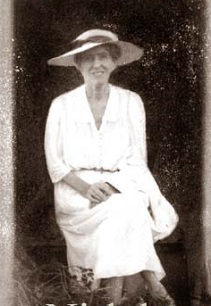 Contact with the article’s author, Swami Nikhilananda, led Margaret Wilson to undertake her largest literary effort. Nikhilananda had translated into English the classic standard work about Sri Ramakrishna, the legendary Hindu mystic of India who embraced all world faiths, and whose teachings would find critical mass appeal among many young Americans in the 1960s. An explicit grasp of the often abstract spiritual concepts put forth in the work required the degree of nuanced understanding which Nikhilananda felt confident Margaret Wilson possessed. This led her to working as an editor of the translation, along with the American professor Joseph Campbell, who would become renowned in the field of comparative mythology and religion and whose own writings became the subject of a book edited by former First Lady Jacqueline Kennedy Onassis. With a foreword by Aldous Huxley, The Gospels of Sri Ramakrishna was published in 1942. Contact with the article’s author, Swami Nikhilananda, led Margaret Wilson to undertake her largest literary effort. Nikhilananda had translated into English the classic standard work about Sri Ramakrishna, the legendary Hindu mystic of India who embraced all world faiths, and whose teachings would find critical mass appeal among many young Americans in the 1960s. An explicit grasp of the often abstract spiritual concepts put forth in the work required the degree of nuanced understanding which Nikhilananda felt confident Margaret Wilson possessed. This led her to working as an editor of the translation, along with the American professor Joseph Campbell, who would become renowned in the field of comparative mythology and religion and whose own writings became the subject of a book edited by former First Lady Jacqueline Kennedy Onassis. With a foreword by Aldous Huxley, The Gospels of Sri Ramakrishna was published in 1942.
 Primarily, however, Margaret Wilson’s life in India focused on her achieving a “state of serenity.” Although she admitted to finding meditation “extremely hard,” she spent a half hour every evening doing so. “There is such a thing as getting near the central psychic being and feeling its influence. And the luminousness of mind that comes afterwards makes me feel as if I have never lived or understood anything at all before! I feel like a discoverer every day,” she reported to a friend in the U.S. Primarily, however, Margaret Wilson’s life in India focused on her achieving a “state of serenity.” Although she admitted to finding meditation “extremely hard,” she spent a half hour every evening doing so. “There is such a thing as getting near the central psychic being and feeling its influence. And the luminousness of mind that comes afterwards makes me feel as if I have never lived or understood anything at all before! I feel like a discoverer every day,” she reported to a friend in the U.S.
When the U.S. entered World War II, President Franklin D. Roosevelt ordered the evacuation of all American citizens from India, which was threatened with invasion by Japan. Margaret Wilson resisted all entreaties from the U.S. government, her sister and friends to leave and return to the U.S. When New York Times reporter Herbert L. Matthews, then in India, managed to interview her on 21 January 1943, she insisted that she was not homesick for her native land. “In fact, I never felt more at home anywhere,” she stated.
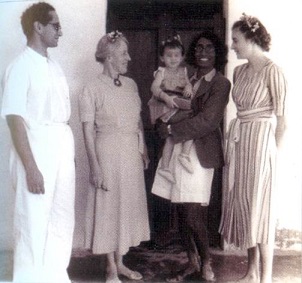
Especially fond of the variety of fresh fruits available to her in India, Margaret Wilson also determined to adapt to the vegetarian diet practiced on the ashram, “even if I have to die as a result.” While she did change her eating habits for several years, she lost a great deal of weight and finally returned to her earlier regiment of vitamin pills, and reverted to a diet which included chicken and fish. She recovered from a serious episode from gout in 1941 to the point where she was able to begin running regularly for the first time in her life. Periodically, Margaret Wilson developed problems with her kidney functioning, but when it was suggested by Indian doctors that she seek medical treatment back in the U.S., she retorted, “True, the doctors in America can take care of my body but who will take care of my soul? My soul is infinitely more important to me than my physical body. I shall stay here.”
In early 1944, she contracted a serious kidney infection and developed uremic poisoning from which she died on 12 February 1944. While Margaret Wilson came to depend upon the guidance of Sri Aurobindo, he became especially moved by the sincerity of her pursuit of inner peace. Long disciplined in keeping his emotions centered and unexpressed, his attendant was shocked to see for the first time that his eyes fill with tears when told that Margaret Wilson had died.
Death:
12 February 1944
Pondicherry, India
Burial:
Sri Aurobindo Ashram
Pondicherry, India
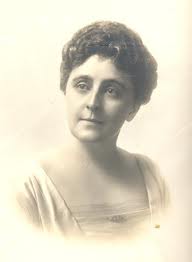 HELEN WOODROW BONES HELEN WOODROW BONES
Birth:
31 October 1874
Rome, Georgia
Father:
James W. Bones, Presbyterian
minister, (4 December 1835, Augusta, Georgia; died Edgefield, North Carolina,
15 April 1916). The son of immigrants from northern Ireland, James Bones began
his college studies at Oglethorpe University in Milledgeville, Georgia in 1853
and completed them at the University of Virginia, in Charlottesville, Virginia.
He enlisted in the Confederate Army on 18 September 1863 as a private in
Company H, Georgia 63rd Infantry Regiment.
Bones was born and raised in
Augusta, where his father had founded a wholesale hardware business, J. &
S. Bones Company, an endeavor which proved so prosperous that the family was
able to build a substantial home on the corner of Greene and Campbell Streets
there. Following his marriage to Marion Woodrow, James Bones bought a home on
Walton Way. James Bones relocated to Rome, Georgia, in July of 1873 to enlarge
the local branch there of his family business, expanded to a partnership a
brother and two cousins, then becoming known as Bones, Brown & Company. The
business became one of the largest construction supply companies in the state
of Georgia. On his own, James Bones prospered after establishing the Stonewall
Iron Company and the Aetna Iron Works. He also served for a time as Rome,
Georgia’s mayor pro tem.
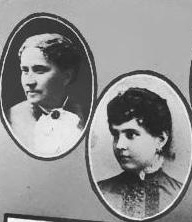 Mother: Mother:
Marion Woodrow Bones, (born
22 November 1832, Carlisle, England, died 24 September 1882, Rome, Georgia) was
the sister of Jessie Woodrow, the mother of Woodrow Wilson. Born and baptized
in England, they Woodrow family relocated to the state of Georgia when the
sisters were young. It was in Augusta, Georgia that Marian Woodrow married
James Bones on 19 November 1861.
Siblings:
Second of three, two sisters;
Jessie Bones Brower (born 25 June 1863), Marion McGran Bones (born 14 November
1866, died 1888)
Religious Affiliation:
Although raised in the
Presbyterian faith, Helen Bones joined the Episcopalian church later in life
and continued that affiliation until her death.
Education:
Public Grammar School, Staunton, Virginia, 1880-1882
Public Grammar School, Rome, Georgia, 1882-1889
Public High School, Rome, Georgia, 1889-1890
Public High School, Chicago, Illinois, 1890-1892
Evelyn College for Girls, division of Princeton
University, Princeton, New Jersey, 1893-1897
Life Before the White House:
Although Helen Bones was the
first cousin of Woodrow Wilson she had grown up knowing Ellen Wilson. Her
father James W. Bones was the elder in the First Presbyterian Church of Rome,
Georgia where Ellen Wilson’s father was the pastor. During the time that James
Bones resided in Augusta, Georgia, he was Sunday school superintendent of the
Presbyterian Church there at the time that his wife’s brother-in-law Reverend Doctor
Joseph R. Wilson (President Wilson’s father) was pastor.
In 1880, when Helen Bones was
six years old, the family moved north to Staunton, Virginia where her maternal
aunt Jessie Wilson was then living with her family. By this time, her elder
sister Jessie had married and remained in Rome, Georgia. Helen Bones was a
month shy of eight years old when her mother died in 1882, prompting her father
to return to live in Rome with her and her remaining unmarried sister Marion.
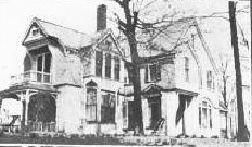 A year later, Helen Bones was
among the family group who welcomed her cousin Woodrow Wilson during his visit
to Rome. Following a Sunday service at the First Presbyterian Church, Wilson joined
a social gathering at the home of Helen’s sister Jessie Brower, where he was formally
introduced to the pastor’s daughter Ellen Axson. An impromptu picnic was
organized at a nearby natural spring, and during the seven-mile ride there in a
wagon, young Helen Bones sat in the front while Woodrow and Ellen sat alone
together in the back, becoming acquainted with each other. They married on 24
June1885. A year later, Helen Bones was
among the family group who welcomed her cousin Woodrow Wilson during his visit
to Rome. Following a Sunday service at the First Presbyterian Church, Wilson joined
a social gathering at the home of Helen’s sister Jessie Brower, where he was formally
introduced to the pastor’s daughter Ellen Axson. An impromptu picnic was
organized at a nearby natural spring, and during the seven-mile ride there in a
wagon, young Helen Bones sat in the front while Woodrow and Ellen sat alone
together in the back, becoming acquainted with each other. They married on 24
June1885.
Within two years of the 1888
death of her sister Marion, the Bones family household dispersed. By this time,
Jessie Brower and her husband and children had relocated to Chicago and Helen
Bones went to live in their home, completing her last two years of high school
in that city. In 1890, her father moved to Atlanta, Georgia, where he prospered
in real estate before finally settling six years later in Edgefield, South
Carolina in the home of a cousin. He resided there for nineteen years, until
his death. The reason his daughter Helen never again lived with him in unknown.
 Despite leaving Georgia, Helen Bones maintained her extensive ties with family members who both remained in the state and had also left. Having been particularly close to her considerably older cousin Woodrow Wilson and his wife Ellen, she was influenced by their encouragement to pursue further education after high school, and then even a professional career. When Helen Bones was nineteen years old, she enrolled at Evelyn College for Women, which was associated with Princeton University where Wilson was employed as a professor. She lived with the family, becoming something of a fourth sister to the three Wilson daughters.
Also part of the household
was Ellen Wilson’s younger brother and he became a brotherly figure for Helen
Bones. President Wilson especially liked to tease Helen Bones, and she felt
free to “egg[ed] him on when he felt foolish, much to everyone’s delight.” Nell
Wilson described her as a “lovely little creature with blue-black hair and
gold-flecked eyes.” Her relationship with her cousin’s wife was as close as it
was to him, and she came to know the familiar and famous faces that crossed
their threshold, including Mary Peck the woman many believed had conducted a
love affair with Woodrow Wilson. Helen Bones declared Mrs. Peck to be
“seductive,” who spoke “caressingly though lazily.”
Upon
graduating from Evelyn College, Helen Bones returned to live in her sister’s
Chicago home. An 1898 Augusta Chronicle
social notice suggests that she made visits to relatives there on special
occasions such as weddings. She also worked as an independent contractor,
employed as a professional book editor of classics and biographies for
publishing houses such as the Flanagan Company and the Beckley-Cardy Company.
Some of the editions she was known to have an expertise with were those
intended for scholastic use. She also wrote editorial introductions,
biographical sketches of authors and notes and guides for the original texts. Among
the works she was known to have produced were Julius Caesar by William Shakespeare, Tales of the Wayside Inn by Henry Wadsworth Longfellow, The Deserted Village by Oliver
Goldsmith, Elegy written in a Country
Churchyard by Thomas Gray, and The
Rime of the Ancient Mariner by Samuel Taylor Coleridge. She also composed
an original biographical overview of author Harriet Beecher Stowe.
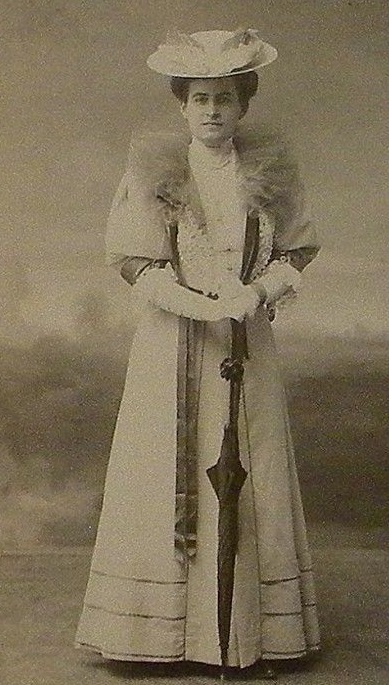 During the presidential
campaign, inauguration and administration of her cousin Woodrow Wilson, Helen
Bones continued to accept professional work as a freelance editor, producing
volumes through at least the first full term of his presidency. During the presidential
campaign, inauguration and administration of her cousin Woodrow Wilson, Helen
Bones continued to accept professional work as a freelance editor, producing
volumes through at least the first full term of his presidency.
The White House:
In January of 1913, Ellen Wilson asked Helen Bones accepted the offer of Ellen Wilson to become personal secretary to the First Lady and handle the massive amount of incoming correspondence she was receiving. Her work began the day before the Inauguration when she was charged with distributing tickets to the various events of the day and finally had to make do with the bathroom floor of the Wilson suite at the Shoreham Hotel as her office, where she calmly got the job done with a military arrangements officer.
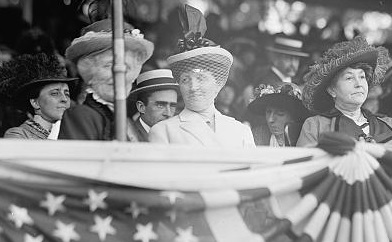 With the dual perspective of
being both a member of the First Family and executive White House staff member,
Helen Bones had a uniquely practical sense of both internal pressures and external
expectations. As Nell Wilson recalled: With the dual perspective of
being both a member of the First Family and executive White House staff member,
Helen Bones had a uniquely practical sense of both internal pressures and external
expectations. As Nell Wilson recalled:
“We all breathed sighs of relief and pleasure when she
arrived. She worked like a small steam engine plowing through stacks of letters
and she still teased and laughed with father, as she had done in the old days…Helen
Bones was the greatest possible help to mother. She took care of all her
personal correspondence, managed the private account books, and relieved her of
many worries and cares…Helen was very popular in every overlapping circle of
Washington society, and I don’t know how any of us could have gotten along
without her. She helped us all in a thousand ways, and fitted perfectly into
the family group. Her room was always a sort of rendezvous; the door was open
all day long, and we drifted in and out, sometimes ending the day with an
impromptu tea around her fire…”
Beyond the practical factors,
the presence of Helen Bones provided the First Lady with a “devoted love and
companionship” which the uncertain Mrs. Wilson often needed and ensured her
presence at important political ceremonies where previous First Ladies may have
felt discomfort appearing. Helen Bones escorted her to the U.S. Capitol
Building to hear President Wilson’s unprecedented addresses before Congress,
first on the tariff and later on banking, in April and June of 1914. She also
joined the First Family during their three-week 1913 Christmas vacation in
Mississippi. When the family friend Mary Peck came to visit the White House,
the First Lady entrusted Helen Bones with the role of chaperoning her and the
President, allegedly former lovers.
As the married presidential
daughters Jessie and Nell developed their own lives and schedules, Helen Bones
became the point person on issues affecting Ellen Wilson. In the spring of
1914, as they grew alarmed over their mother’s obvious exhaustion, they
interceded with Helen Bones, asking her to cancel the First Lady’s schedule of
meetings with the National Civic Federation and Committee of Fifty, which were
spearheading Ellen Wilson’s slum clearance bill. However much she might have
wished to intercede and prevent the First Lady from taking unnecessary risks to
her health, Helen Bones made her professional role the priority; in respecting
the First Lady’s wishes, Helen Bones refused to comply with the Wilson
daughters, explaining that the First Lady “had her heart set on getting the
bill for better housing conditions in Washington passed by Congress, and that
she would not spare herself.” She nevertheless provided the daughters with
frank reports on their mother’s condition and coaxed them into closer contact
with her.
Surrogate First Lady Role
September 1914 - December 1915
In the sixteen month period between the death of his first wife and his remarriage to his second wife, the efforts of the President’s cousin on his behalf were publicly more obscure than that of his daughter. This interim period nevertheless underlines the usually multiple roles assumed by a First Lady who is the president’s wife. Helen Bones assumed the more private roles of confidante and caretaker for her widowed cousin, while Margaret Wilson took on the public ones of hostess and civic leader. Helen Bones did first serve as an assistant hostess on 13 March 1914 to Ellen Wilson and continued to do so following her death, when Margaret Wilson assumed the status of presidential consort at the relatively few formal functions during this interim period. There seems to be scant suggestion, however, that Helen Bones served as the presidential consort at formal dinners though she did receive guests as hostess alongside the President in Margaret Wilson’s absence.
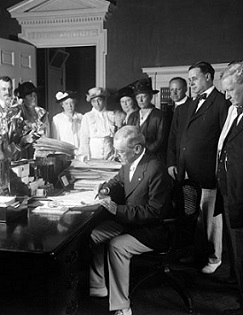 Helen Bones played a
primarily supportive role to the widowed President, who was famous for his
emotional dependency on women around him. Since Margaret Wilson did continue to
commute to New York in pursuit of her singing and musical career, then assumed
a more active role in pre-war activities, it was the President’s cousin who
became his primary female companion and oftentimes his only family member who
lived continuously with him in the White House. Her presence was important to
him as a supportive figure, ensuring that his physical and mental health did
not falter. On at least one occasion, Helen Bones also came into the Oval
Office to witness the President sign federal legislation in a gesture of
personal support to him. She too was deeply depressed by the death of Ellen
Wilson, whom she upheld as an ideal; every aspect of the White House reflected
the taste and changes made by her friend. Her absence also made it all the more
apparent just how dependant the President had been on his wife. After his death,
Helen Bones confessed to a biographer that his wife’s death marked “the ending
of Woodrow’s best self.” Helen Bones played a
primarily supportive role to the widowed President, who was famous for his
emotional dependency on women around him. Since Margaret Wilson did continue to
commute to New York in pursuit of her singing and musical career, then assumed
a more active role in pre-war activities, it was the President’s cousin who
became his primary female companion and oftentimes his only family member who
lived continuously with him in the White House. Her presence was important to
him as a supportive figure, ensuring that his physical and mental health did
not falter. On at least one occasion, Helen Bones also came into the Oval
Office to witness the President sign federal legislation in a gesture of
personal support to him. She too was deeply depressed by the death of Ellen
Wilson, whom she upheld as an ideal; every aspect of the White House reflected
the taste and changes made by her friend. Her absence also made it all the more
apparent just how dependant the President had been on his wife. After his death,
Helen Bones confessed to a biographer that his wife’s death marked “the ending
of Woodrow’s best self.”
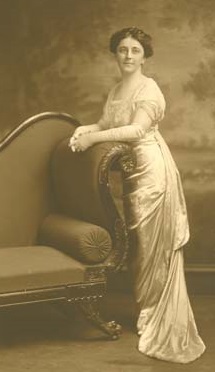 In the autumn of 1914, as the
weeks went on after the First Lady’s death and Helen Bones spent the entire
focus of her waking hours on the President as his caretaker. Her efforts
strained and soon broke her emotional state and caused physical exhaustion. The
President’s physician Dr. Cary T. Grayson placed her under the care of two nurses.
He had become unusually familiar with his charges, the members of the First
Family and developed a personal relationship with Helen Bones. On 6 May 1914,
just two months of the Wilson Administration began, the doctor brought along
his girlfriend Altrude Gordon with him to join President Wilson, Margaret
Wilson and Helen Bones at the circus. The day before, Altrude Gordon had lunch
with a friend she and Dr. Grayson had made two years earlier, the widow Edith
Galt of Washington. In the autumn of 1914, as the
weeks went on after the First Lady’s death and Helen Bones spent the entire
focus of her waking hours on the President as his caretaker. Her efforts
strained and soon broke her emotional state and caused physical exhaustion. The
President’s physician Dr. Cary T. Grayson placed her under the care of two nurses.
He had become unusually familiar with his charges, the members of the First
Family and developed a personal relationship with Helen Bones. On 6 May 1914,
just two months of the Wilson Administration began, the doctor brought along
his girlfriend Altrude Gordon with him to join President Wilson, Margaret
Wilson and Helen Bones at the circus. The day before, Altrude Gordon had lunch
with a friend she and Dr. Grayson had made two years earlier, the widow Edith
Galt of Washington.
As Helen Bones gained some
strength, Grayson held her to a strict regiment of vigorous outdoor walking. He
also began attempting to coax Mrs. Galt into going on the long walks with “the
poor little lady” Helen Bones who he said was “starving for companionship.”
Mrs. Galt retorted that she “never had contacts with official Washington” and
didn’t seek any, especially at that level. In time, however, she relented to
the point where she and Helen Bones became afternoon walking companions in
Washington’s Rock Creek Park some three days a week. In March of 1915, Helen
Bones convinced Edith Galt to overcome her resistance to returning to the White
House with her for tea, after their walk, the widow claiming that she was
ashamed of her muddy shoes. Helen Bones told her there was no chance they would
run into the President, since he was out playing golf with Dr. Grayson. As the
two women entered the family quarters of the White House, however, so too did
the two men.
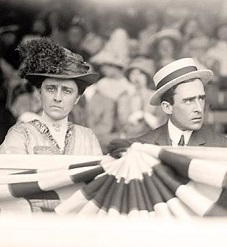 A later account, however,
suggests that Edith Galt’s “accidental” meeting of the President had been
deftly coordinated by Dr. Grayson and Helen Bones out of concern for Wilson’s
ongoing depressive mood. Several months earlier, when he and Grayson had been
driving through Washington, the doctor saw Edith Galt walking on the street and
waved to get her attention, which she acknowledged. Wilson looked at her and
expressed interest in her, asking, “Who is that beautiful woman?” Within days,
the President asked Helen Bones to arrange a 23 March 1915 White House dinner
with Edith Galt as guest. From that point on, Edith Galt was at White House
lunches and dinners with the President, identified publicly as “a guest of his
cousin.” Soon Helen Bones was serving as the conduit through which love letters
between President Wilson and Edith Galt were surreptitiously conveyed. A later account, however,
suggests that Edith Galt’s “accidental” meeting of the President had been
deftly coordinated by Dr. Grayson and Helen Bones out of concern for Wilson’s
ongoing depressive mood. Several months earlier, when he and Grayson had been
driving through Washington, the doctor saw Edith Galt walking on the street and
waved to get her attention, which she acknowledged. Wilson looked at her and
expressed interest in her, asking, “Who is that beautiful woman?” Within days,
the President asked Helen Bones to arrange a 23 March 1915 White House dinner
with Edith Galt as guest. From that point on, Edith Galt was at White House
lunches and dinners with the President, identified publicly as “a guest of his
cousin.” Soon Helen Bones was serving as the conduit through which love letters
between President Wilson and Edith Galt were surreptitiously conveyed.
Like Dr. Grayson, there is
some suggestion that by introducing Edith Galt to the President Helen Bones had
intended only to provide her ailing cousin with feminine companionship and grew
concerned that the romance had progressed too swiftly. She was not known to
have directly expressed her opposition to their marriage but the first spark of
conflict arose between the two women once Edith Galt had accepted the
President’s marriage proposal. Helen Bones urged her cousin not to make a
public announcement of his engagement until two especially close family friends
had first been told by him personally. Edith Galt reacted with impatient anger
at this and the President acquiesced to her demand that the announcement be
made sooner.
In the effort to avoid any
suggestion that Wilson’s remarriage just fifteen months after Ellen Wilson’s
death was being done without family approval, the public was given repeated
evidence that both Helen Bones and Margaret Wilson approved of not only the
union but were close friends of Edith Galt. Both were guests at the formal
engagement dinner at the White House along with numerous members of the bride’s
family. On 11 October 1915, for example, when the President was making his
first public appearance following announcement of his engagement, Edith Galt
was chaperoned to publicly appear at the event by Helen Bones as an “official”
representative of the First Family. When the newlyweds made their honeymoon
trip into Virginia, following the Galt house wedding which Helen Bones
attended, the President’s cousin wrote a generous letter to the “Beautiful
Bride,” thanking her for the knowledge now of “how happy our deal Blessed Man
is…”
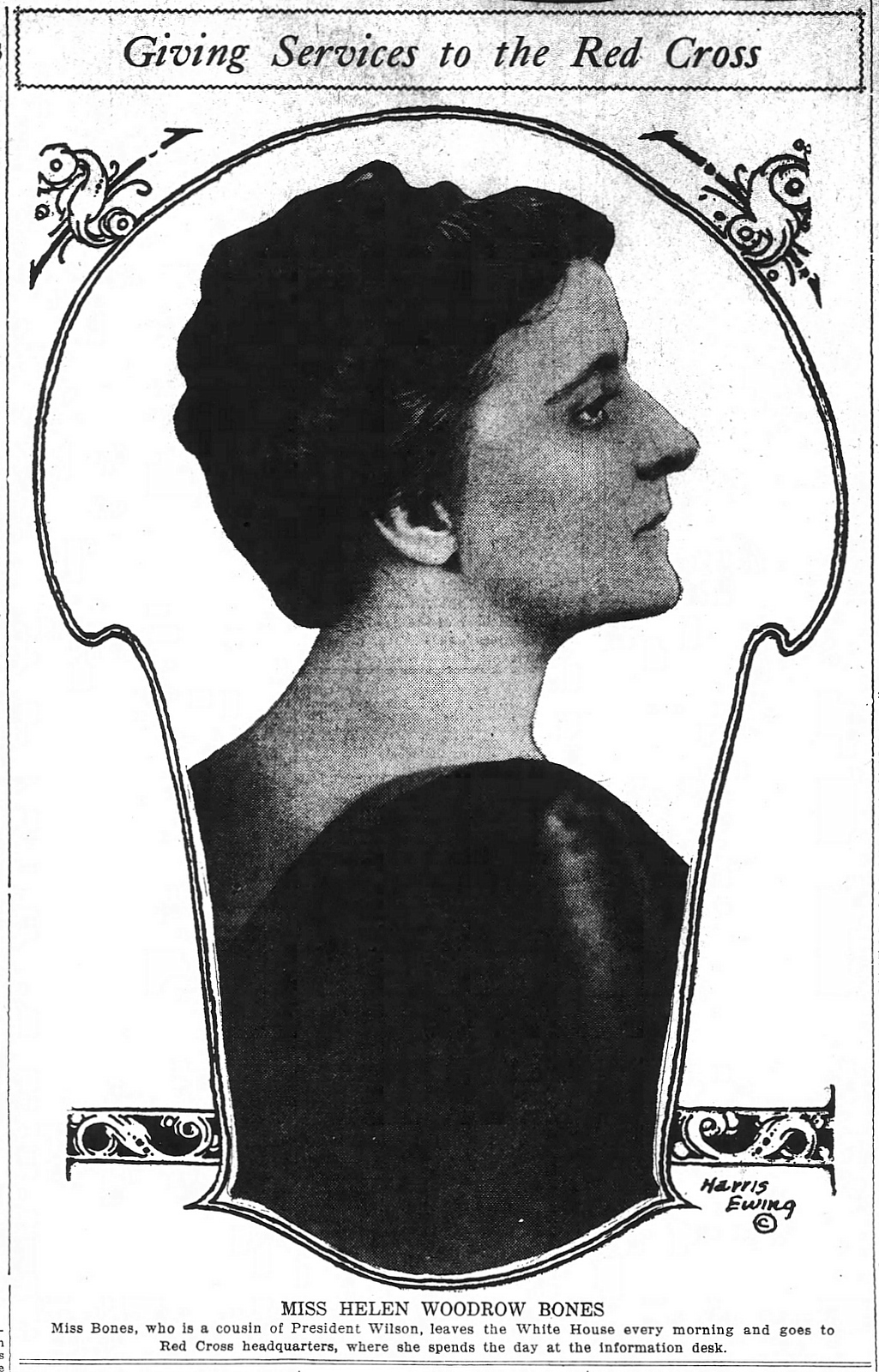 During the 1916 presidential
campaign, Helen Bones remained part of the presidential household, moving with
the Wilsons to Shadow Lawn, the New Jersey home they used that summer and fall.
As the second Wilson term began with a new presidential wife, Helen Bones
continued to live in the White House. Following the U.S. entry into World War
I, she and Edith Wilson worked together in a volunteer sewing to output some
fifty pairs of soldiers’ pajamas, sheets and pillowcases, which were then
donated to the Red Cross to be distributed for practical use but also as a
symbolic gesture intended to set an example for American women. Throughout the
war, Helen Bones worked as a volunteer, walking each morning from the White
House to man an informational booth for incoming soldiers in Union Station. During the 1916 presidential
campaign, Helen Bones remained part of the presidential household, moving with
the Wilsons to Shadow Lawn, the New Jersey home they used that summer and fall.
As the second Wilson term began with a new presidential wife, Helen Bones
continued to live in the White House. Following the U.S. entry into World War
I, she and Edith Wilson worked together in a volunteer sewing to output some
fifty pairs of soldiers’ pajamas, sheets and pillowcases, which were then
donated to the Red Cross to be distributed for practical use but also as a
symbolic gesture intended to set an example for American women. Throughout the
war, Helen Bones worked as a volunteer, walking each morning from the White
House to man an informational booth for incoming soldiers in Union Station.
By the time World War I
began, Edith Wilson had been married to the President for sixteen months and as
a presidential spouse would have otherwise been viewed as the sole “First Lady”
of the Administration but the continued presence in the Wilson White House of
his unmarried daughter and niece raised questions of, as one newspaper headline
put it, “Who is the First Lady of the land?”
A formal 7 December 1916 dinner
honoring the Vice President and Cabinet, seemed to have answered the question
with the publication of those in attendance; Helen Bones and Margaret Wilson
were no longer identified as members of the presidential household but rather
as “guests” of the “President and Mrs. Wilson.”
When
the President made his unprecedented transatlantic voyage to become the first
incumbent to visit a foreign country, the First Lady took Social Secretary
Edith Helm along as administrative aide rather than Helen Bones. This doesn’t
necessarily indicate a break in the relationship between the President and his
cousin or her family, it may well simply have been a matter of her desire to
resume her professional career as a book publishing editor in New York. While
the Wilsons were in Europe, for example, they welcomed Jessie Brower, the
married sister of Helen Bones, then living in Paris, as their frequent dinner
guest.
Life after the White House
Unlike
Margaret Wilson who continued to maintain a room in the White House, by the time
the President and Mrs. Wilson returned from Europe in 1919, Helen Bones had
vacated the White House as even a part-time residence. Her Rome News-Tribune obituary of 5 June 1951 indicates that she moved
out in early 1919 and the 1920 census lists her home as New York’s Stratford
House residential hotel for women at 11 East 32nd Street. This
corroborates with the fact that Edith Wilson’s brother Randolph had, by then,
begun functioning as his sister’s private secretary and assumed the work Helen
Bones had continued to do for the second wife of her cousin as she had for the
first. She returned to Washington, D.C. for the funeral of former President
Wilson in 1924, invited by Edith Wilson to join the official party of family
members for the private service as well as the public one.
It had been during the Wilson Administration that the father of Helen Bones had
died and she’d returned home to arrange his funeral and serve as executor of
his substantial estate. Although she continued to work as a copy-editor and
editorial-writer on a contractual basis, she no longer depended on this for an
income and found herself able to even dabble on Wall Street. Despite the fact
that Edith Wilson assumed the full control of her late husband’s legacy, Helen
Bones was included in several efforts intended to honor him. While producer
Daryl Zanuck gave the president’s widow carte blanche to edit the working
script used for Wilson, the feature
film about his presidency, he also provided a copy to Helen Bones for her
approval since she was depicted as a character in the drama.
Although an estrangement had existed between Edith Wilson and her husband’s
daughter and son-in-law Nell and William McAdoo from the time of his death,
Helen Bones remained on polite but increasingly distant terms with her. The
break seemed to come when Edith Wilson determined not to have Ellen Wilson’s
oil paints, brushes and canvas easel publicly displayed at the Woodrow Wilson
Birthplace museum but rather stored out of sight in the basement; in loyalty to
Ellen Wilson, Helen Bones registered her disapproval. When a biographer of
President Wilson later interviewed Helen Bones about Edith Wilson she revealed
that the second Mrs. Wilson was “sensitive” about references to Ellen Wilson,
his first wife and that one must be cautious in questioning her for she would
easily shut one out. `“Edith Bolling Wilson and I never came to blows but she
stopped liking me and I certainly stopped liking her towards the last.”
Upon
the end of her working years in New York, Helen Bones returned to her original
home of Rome, Georgia, initially living in the residential Greystone Hotel and
Apartments and then later in the home of widow Virginia Lytle. In ill health for about
a year, she died in a local hospital. She named Marion Cooper, the married
daughter of her niece Marion Erskine as her sole heir.
Death:
4 June 1951
Rome, Georgia
Burial:
Myrtle Hill Cemetery
Rome, Georgia
|